Graduate Student Workers Union Walks Out
By MADELYN KINZEL AND ALEXA VILLATORO Staff Writer and News Editor
Fordham Graduate Student Workers (FGSW), the labor union representing 360 of the university’s graduate student workers in the Graduate School of Arts and Sciences (GSAS), walked out from April 24 to 26 following unsuccessful contract negotiations with the university. The union is demanding an increase in wages and more support for international graduate student workers, as well as workplace protections.
FGSW’s proposed contract will be the first to be negotiated between the union and Fordham.
In an Instagram post released on April 20, FGSW shared that graduate students decided to walk out due to the university’s unwillingness to meet the union’s proposals after seven months of bargaining. The union also released their walkout schedule the same day.

Molly Crawford, a doctoral candidate in theology and member of the FGSW coordinating committee, said that although the union aims to make Fordham “stronger, safer, and more thriving,” she believes the university is not bargaining in “good faith.”
see FGSU page 5
Tense Future for Women’s Basketball
By AURELIEN CLAVAUD
Creative Director
Anyone who has been following Fordham Athletics will have noticed the buzz surrounding the women’s basketball team. In two short years, a decadelong coaching regimen was dismantled, and an entire team was broken apart. It is not uncommon for new coaches to arrive at a college program and encourage players to enter the transfer portal — or for administrations to release an entire coaching staff at once — but seeing this play out at Rose Hill hits home for those who’ve enjoyed the recent success of the Rams.
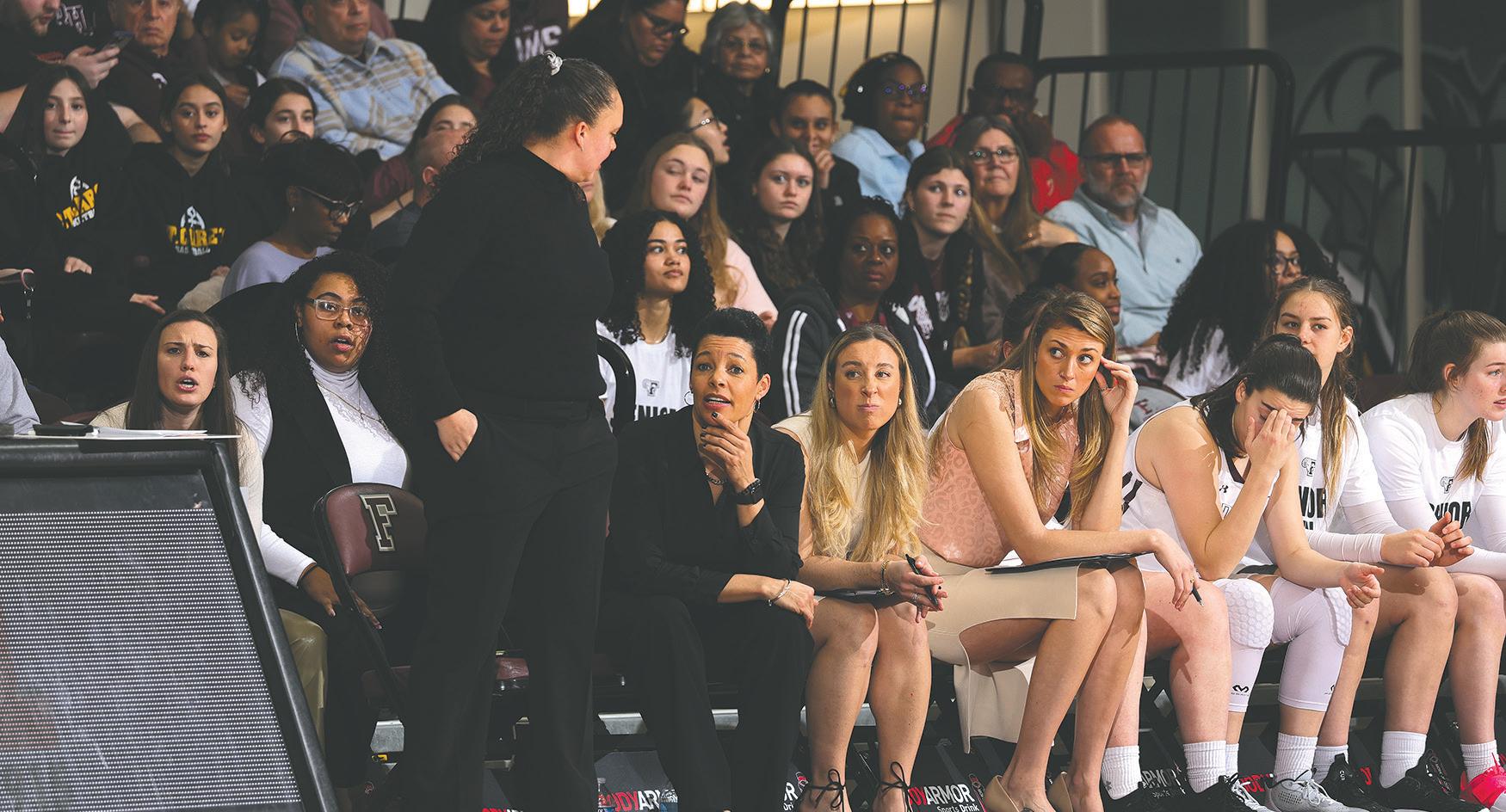
Stephanie Gaitley, former head basketball coach at Fordham and
Fazal Elected as President
BY TARA LENTELL
Former Layout Editor
Election results for the United Student Government at Lincoln Center (USGLC) presidential race were announced on May 1 in an Instagram post. According to Christina Frankovic-Sepsi, director of the Office for Student Involvement (OSI), an estimated 275 people voted in this year’s elections.
The window to vote began on April 27 and concluded on April 28 at 5 p.m. Results were announced on May 1, through a post on USGLC’s Instagram. Out of the 14 races, only two elections were contested: the presidential and first-year senatorial races.
For the presidential race, Tanzema Fazal, Fordham College at Lincoln Center (FCLC) ’24 and president-elect of USGLC, won with 45.80% of the vote. She was followed by Djellza Pulatani, FCLC ’24 and the incumbent, who received 41.50% of the vote, and Shadman Sakib, FCLC ’24, who earned 8.70% of vote. The remaining 4% was composed of write-ins.
see USGLC page 4
current head basketball coach at Fairleigh Dickinson, served as a great sigh of relief for fans in 2011, when she took command of the faltering squad. Her reputation as a winning coach at St. Joseph’s, Long Island and Monmouth universities preceded her, and hope abounded for the Fordham women’s basketball team. She radically transformed the Fordham basketball brand, taking the team to the first round of the NCAA tournament first in 2013-14 and then again in 201819. It was by and large a tremendously successful turnaround for the program since they had not made it to the postseason since 1994.
“When I took over, we hadn’t had a winning season in 25
years,” Gaitley said. “We had an incredible culture that we built there. This group cared about each other, and they wanted each other to be successful.”
And so for many, it came as a surprise when Gaitley was quietly let go in June 2022 following an 18-11 season. According to her, she stepped away to protect the image of the team following a troubled past at St. Joseph’s University, where she was let go in a high-profile manner related to an internal investigation. While leaving silently prevented controversy from affecting the team, it raised many questions regarding the future of the team.
World Premiere of ‘La Cocina’ Leaves the Stage Sizzling
By SOPHIA GRAUSSO Staff Writer
“La Cocina,” a Fordham Theatre mainstage production, takes place in the hot-tempered kitchen of a well-established restaurant that relies on the hard work (and subliminal exploitation) of its working-class employees. The play, written by Interim Head of Playwriting Tony Menesses, ran from April 13 to April 22 in Pope Auditorium and was the final mainstage show of the semester.
The setting, all within a day’s work, begins with the employees clocking in, watching the kitchen and waiting staff trickle into an expansive restaurant full of everyone’s food service classics: brown crate barrels doubling as seats and tables, stainless steel surfaces with century-old stains, cubbies with forgotten memorabilia. The set of “La Cocina” — designed by Katie Heaton, Fordham College at Lincoln Center (FCLC) ’23 — could not be more perfectly staged.
The kitchen staff chew the fat as they come into work, gossiping about the drama among their co-workers from the night before, which makes up the meat of “La Cocina’s” main conflict: the exploited workers behind the food being prepared. The audience catches glimpses of
each worker’s perspective, piecing together that Wesley (Aiden Castillo, FCLC ’26), a waiter who attempted to kiss Pablo (Josiah Rivera, FCLC ’23), a kitchen worker, on the cheek. This led to a physical altercation between the two and a threat from Wesley to call Immigration and Customs Enforcement (ICE). Though Wesley doesn’t follow through on this, the mere mention of calling ICE frightens the migrant workers who compose a majority of the custodial staff.
“La Cocina’s” central plot brings attention to the food service industry’s reliance on the exploitation of migrant workers, who are typically overlooked, overworked and underpaid. The other staff members display an envious acceptance to take on the remaining “back-of-house” workload, a term utilized in the restaurant scene to refer to the preparations customers don’t see. This is also frustrated by extra work that other staff members have deemed outside of their realm of responsibility.
This nature of workers being juxtaposed against one another demonstrates a cyclical nature of exploitation: The staff can afford neither friend nor foe as their personal relationships come second to the rule of Sylvia (Isabella Acuña, FCLC ’25), the restaurant manager.
NEWS PAGE 3 Minor Creation A step is taken to increase comfort among Asian Americans OPINIONS PAGE 12 Faltering Support The university needs to better support its Black student population ARTS & CULTURE PAGE 13 Camelot’s Revival New production of “Camelot” satisfies the 1960s original version CENTERFOLD PAGE 8 Butler Gallery Seniors unite to discuss their showcased art SPORTS & HEALTH PAGE 6 Baseball Gloom Fordham baseball continues to fall in the A10
see LA COCINA page 14
AURELIEN CLAVAUD/THE OBSERVER
A graduate student worker holds up a sign calling on the administration to bargain with the union.
AURELIEN CLAVAUD/THE OBSERVER
Green discusses with assistant coaches Jennings, Holden and Brown.
The
Observer May 3, 2023 VOLUME XLIII, ISSUE 7 the
see WOMEN'S B-BALL page 7
STudenT Voice of fordham LincoLn cenTer
Fordham Launches Asian American Studies Program
The new course of study draws upon various departments and disciplines to encourage cross-racial conversations, alliances, projects and initiatives
By SABRINA VIDAL Staff Writer
Following a two-yearlong effort, Fordham College at Lincoln Center (FCLC) announced the creation of the Asian American studies (AAST) program on April 3. The program offers students a variety of courses across different disciplines relating to Asian American issues.
James Kim, associate professor of English and comparative literature, and Stephen Hong Sohn, professor of English and Thomas F.X. and Theresa Mullarkey chair in literature, were the co-directors of the program and called for its creation among other members of the Asian American studies working group.
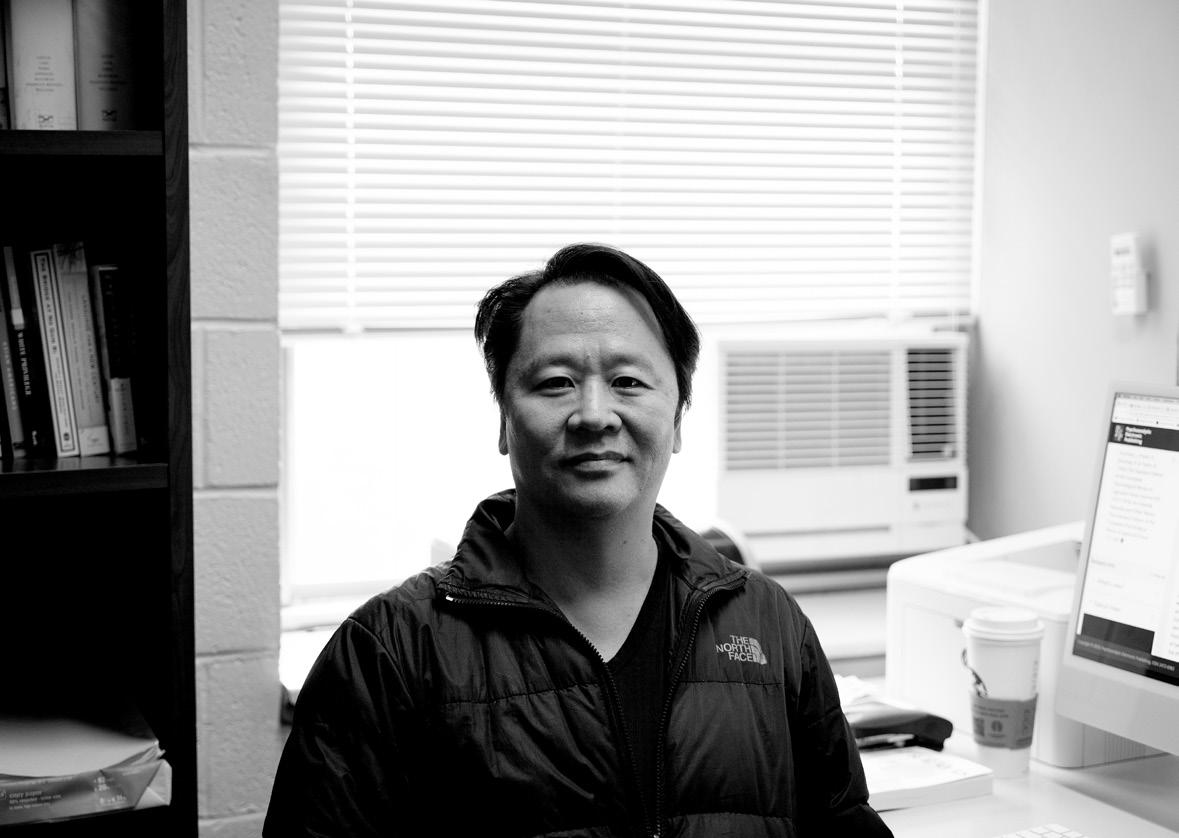
The efforts to create an AAST program at Fordham gained momentum amid a rise in anti-Asian violence during the COVID-19 pandemic. Asian American faculty mobilized following the fatal shootings of eight people, including six Asian women, in Atlanta in March 2021 to create a program that would educate the Fordham community on issues affecting the Asian American community.
A petition for an AAST program was created by Kim and the petition quickly gained traction, garnering over 1,400 members of the Fordham community.
“So many students signed the petition for Asian American studies and expressed such strong support for the initiative,” Kim said. “It really energized us to see their enthusiasm.”
The co-directors decided to launch the effort to create the AAST minor when asked to
educate the Fordham community on anti-Asian racism and provide a safe space for Asian American faculty, students and staff.
“We can’t just respond in times of crises,” Sohn said. “We need a structure that is already in place so that if bad things happen, then we can rally around it with the resources that we already have in place.”
Kim felt that there was a strong contrast between the reception of the petition circulated during the spring of 2021 and the support for AAST when he first began working at the university in 2004. He points to the political changes and new generations of students as reasons for this change, as well as the development of a university community that’s more receptive and invested in the idea of building AAST.
Following the overwhelming advocacy shown in the 2021 petition for AAST, the program also received support from the Fordham administration. Both Kim and Sohn began applying for internal funding from the university and won funds from the Deans’ Faculty Challenge Grant and the Teaching Race Across the Curriculum Grant in the amounts of $10,000 and $15,000, respectively.
The funds allowed them to form the Asian American studies working group, composed of professors across different disciplines and departments of the university, to begin training faculty to teach AAST.
“It’s been a special honor to work with other members of the faculty working group, many of whom took on the monumental
task of training themselves in Asian American studies so that they can design and teach credible courses in the field,” Kim said.
After two years, the minor in AAST was finally approved by the Dean’s Council in the fall of 2022 and was cleared to begin its programming this spring for the upcoming 2023-24 academic year. It will be led by Sohn and Caitlin Beach, assistant professor of art history, while Kim pursues a research sabbatical.
Beach noted that she believes this is a celebratory moment to reflect with students and members of the Fordham community about what the future of Asian American studies will be composed of in the following years.
“I think it will be an exciting chance to build this program together with this broader community at the university,” Beach said.
The official launch of the program was met with excitement by students who have been awaiting the program’s launch, some of whom wish they could have taken part in it during their time as undergraduates at the university.
Shan Rao, FCLC ’22, who majored in English while at Fordham and a former student of Sohn’s, was interested in the creation and development of the Asian American Studies minor prior to graduating. said that she wished she could have participated in the program during her time as an undergraduate but applauds the opportunity now made available to others.
“I’m happy to know that future students will now have a wider range of Asian American related
courses available to them and be more easily able to find the courses that already exist,” she said.
Yeenon Yu, FCLC ’23 and a major in English with a minor in African and African American studies, also expressed regret at not being able to participate in the minor before her upcoming graduation but said she is excited about the program’s inception.
“I hope that there is more inclusivity and more understanding of how important it is to learn about Asian American studies,” she said.
According to Kim, the AAST program is built upon the foundation of solidarity between individuals and communities of different races. He said he hopes that the minor will encourage cross-racial conversations, alliances, projects and initiatives to take place among students
and faculty. In line with its goal of coalition building, the minor requires students to take at least one course in either the African and African American studies department or the Latin American and Latinx studies program.
“We want our Asian American studies students to be thinking about Asian racialization in relational terms,” he said. “You can’t understand Asian racialization in the contemporary United States in isolation.”
Sohn connected the aim of race and ethnic studies to the university’s cura personalis values, which stress caring for the whole person. The faculty behind the AAST program said that they encourage interested students to enroll in one of its course offerings in the upcoming 2023-24 academic year.
Students Share Mixed Experiences Utilizing Fordham’s Wi-Fi
By ANDREW ARMOUR Staff Writer
Students have expressed concerns regarding gaining access to a reliable internet connection, with some claiming that they have experienced these difficulties during class registration periods where many students are using the Fordham Wi-Fi at once.
Katherine Egan, executive director of IT administration, said that the university is aware that students have experienced difficulty during registration.
Egan describes that when registration opened for the fall 2023 period, all students were able to register successfully until the fourth group, which consisted of over 2,700 students.
“Many students tried to register exactly at 8 a.m ... about 1,800 students successfully registered in the first 10 minutes, then the system began having server issues,” she explained. “IT, along with the Academic Records team pulled (the server having problems) out of the system, addressed the issue, and put it back online.”
Egan notes that difficulties experienced during this past course registration process are attributed to the university’s student information system (SIS), which supports the registration process, not internet connectivity issues. However, students have shared concerns that issues they have experienced are attributed to a faulty internet connection.
Willa Richards, Fordham College at Rose Hill (FCRH) ’26, said she felt frustrated completing her
course registration for the fall 2023 semester.
“Registration definitely is a struggle. Every time so far I’ve had issues with the (Wi-Fi) system,” she said. “I had to wait two hours to sign up for classes. Last semester I tried a personal hotspot, but it didn’t help too much.”
Viviana Flores, Fordham College at Lincoln Center (FCLC) ’26, also shared frustrations with the university’s registration process and referred to the process as “unexpectedly and unnecessarily stressful.”
She added that while she tends to have an overall positive experience with campus Wi-Fi, she always relies on her personal hotspot to avoid connectivity issues. During this past registration period, however, Flores expressed disappointment because her efforts to connect to her hot-spot were not helpful due to the registration system crashing.
“Something about the virtual race to specific classes, at a
specific time, at a specific campus, and the impending possibility that the schedule you already have perfectly planned out will not come to fruition causes a wave of anxiety and adrenaline on registration morning.” she said.
Egan noted that IT suggests using only one device and one browser window when registering for courses, waiting five seconds to reload pages, confirming a lack of holds on the student’s academic account, registering on the assigned day and calling the IT Service Desk after troubleshooting.

Katherine Morris, FCRH ’22 and the university’s current IT communications manager, says that less than 50% of bandwidth capacity is being used by Fordham Wi-Fi users on a given day at either campus. Despite this, some students have had difficult experiences connecting to campus Wi-Fi aside from course registration periods.
Sophie Bronstein, a postbaccalaureate premedical student
GRAPHIC BY AURELIEN CLAVAUD / THE OBSERVER
at FCLC, shared that she has had poor experiences utilizing the Lincoln Center Wi-Fi. She noted that the network at Lincoln Center does not recognize her credentials and felt that connectivity at the Rose Hill campus is better. She said that she has had issues with losing connection and disconnecting from the Wi-Fi at Lincoln Center but not at Rose Hill.
Bronstein has also encountered experiences with her virtual ID failing to load on her phone while connected to the Lincoln Center campus Wi-Fi.
Unlike Richards and Bronstein, some students have not expressed the same frustration with on-campus internet connections. Flores said that she has had an overall positive experience with her Wi-Fi connectivity aside from issues faced during class registration.
“I have not had any serious issues with the Wi-Fi this year, apart from a few crashes or instabilities that seem to correct
themselves in seconds,” Flores said.
According to Morris, IT actively monitors connectivity issues and regularly tests the university’s Wi-Fi network by loading popular sites such as Google, Facebook and Netflix and assessing the wireless connection on speedtest sites. She added that the office looks at all service tickets to review coverage issues and said that the on-campus Wi-Fi connection has never maxed out because of the quantity of devices attempting to access the network. Morris said that the Wi-Fi is impacted by numerous external forces that can affect coverage and speed.
Regarding technical issues associated with class registration, Egan noted that IT and Fordham’s SIS vendor are addressing potential solutions while the university investigates other options.
According to the IT department, the university underwent its most recent remodeling of its wireless network in 2017 in an effort to mitigate the interference students, faculty and staff experience. In addition, a “concerted effort” is being made to remedy any issues that have persisted with FCLC receiving a recent fiber repair in February 2023.
The Office of Information Technology encourages all members of the Fordham community to submit service tickets for IT services, including accessing the Wi-Fi network by emailing HelpIT@fordham.edu, calling 718-817-3999 or visiting the Tech Help page in the portal.
AURELIEN CLAVAUD/THE OBSERVER
Kim developed Asian American studies alongside Sohn in response to a rise in anti-Asian violence.
While the Office of Information Services reports that connectivity issues are not attributable to Fordham’s Wi-Fi, students have noted lapses in strong network connection
2 News May 3, 2023 THE OBSERVER www .fordhamobserver.com
Faculty Senate Negotiates New Contracts
By ANA KEVORKIAN Managing Editor
Fordham University and its tenure-track faculty members have reached a contract agreement on compensation increases and changes to health benefits for tenure-track faculty following negotiations that began in mid-December. Three weeks after University President Tania Tetlow, J.D., announced a 6% increase in tuition, citing “rising demands for compensation from our employees” as a driving force behind the decision, the Faculty Senate — which represents tenure-track faculty in negotiations with the administration — voted 13-5-2 on April 21 to approve the proposal.
The final proposal had been recommended by the Salary and Benefits Committee, and it was signed by both Tetlow and Faculty Senate Chair John Drummond. Both of the parties had deliberated over about nine to ten proposals before coming to an agreement.
Drummond declined to comment on the negotiations or the agreement.
Hepp said he believes that while both the Faculty Senate and the Salary and Benefits Committee have been cognizant of the university’s budget situation, the main concern of the latter was that faculty members maintain “purchasing power,” meaning they are able to afford the same expenses, even with high inflation rates. He added that he believes nobody in either group was particularly satisfied with the agreement but referred to it as the best agreement that could be reached given the fiscal circumstances.
“These proposals basically ensured that the purchasing power of faculty members did increase over the contract period,” he said. “We are aware that there might be further erosion of purchasing power on faculty members in the coming years, unless inflation comes down significantly.”
Thierry Rigogne, associate professor of history and associate chair of undergraduate studies at Lincoln Center, said the current inflation rate of 6% in New York City means that faculty raises and benefits will not keep pace and thus amount to, in effect, a reduction.
Rigogne also emphasized that the tenure-track faculty had already accepted decreases in compensation during the pandemic in order to avoid layoffs, but that those cuts will not be restored due to the new contract.
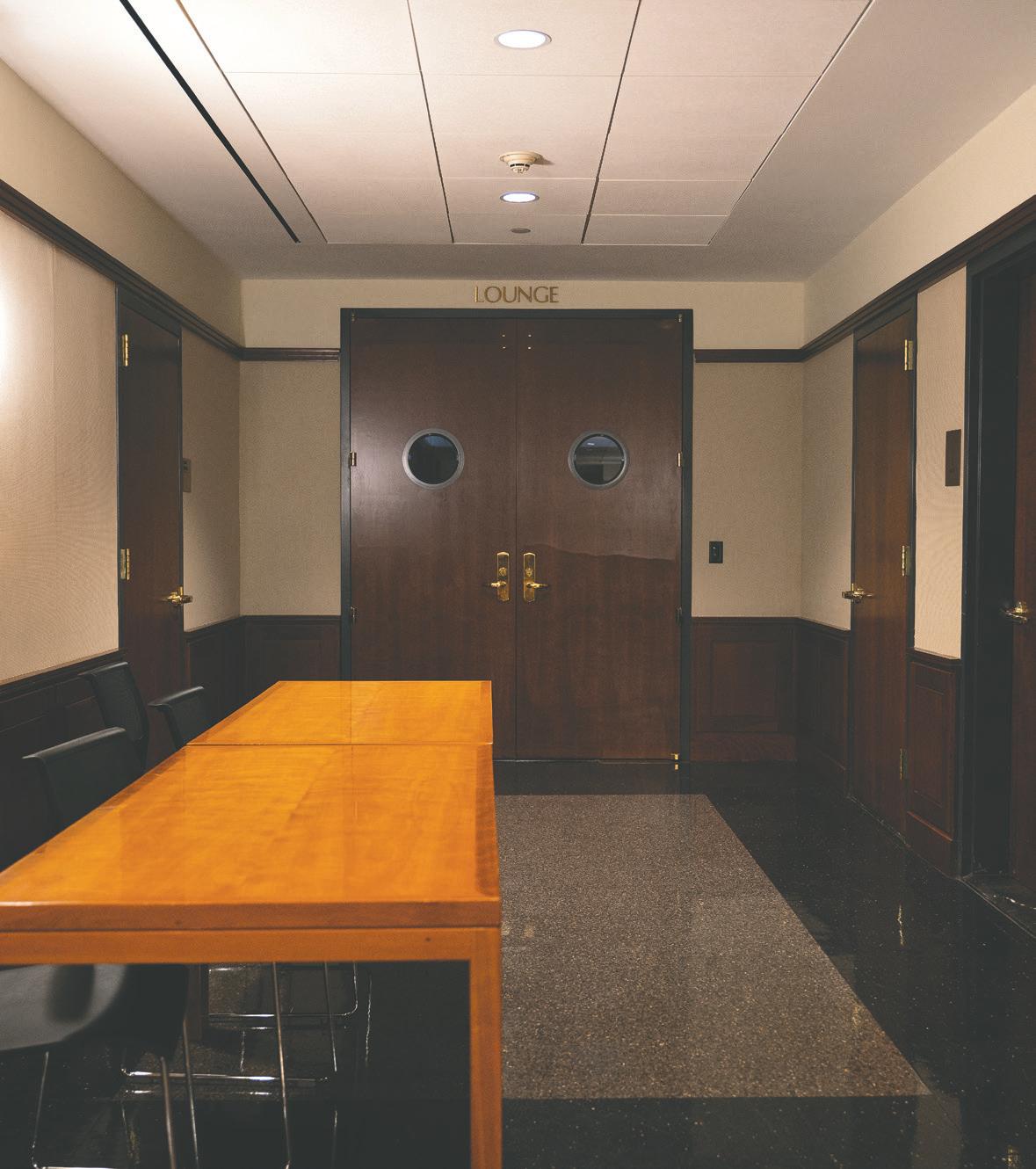
“We feel like the administration takes credit for keeping the university going, and we had to redo our entire courses and teach from our kitchens, all while taking pay cuts,” he said of teaching during the pandemic.
thought our priorities should be, and what was realistic,” she said.
Lockhart also expressed concern regarding the university’s ability to attract top-tier talent due to the lack of competitive compensation, calling into question its long-term sustainability.
Throughout 2022, negotiations between the university and Fordham Faculty United (FFU), the union representing adjunct and nontenuretrack faculty, nearly led to a strike in January on the part of union members who demanded higher compensation and a health benefit. .
Bob Howe, associate vice president for communications and special adviser to the president, explained that the university raised faculty salaries by as much as it was able to while operating within its financial constraints. He noted that the agreement will include a pay increase higher than compensation raises in the recent past due to the inflation concerns.
and FFU that lasted over a year, Tetlow said that budget constraints made it difficult to accommodate the union. In an email sent to the Fordham community on Nov. 18, the president implied that the university was unable to meet FFU’s demands because of the segmented nature of the faculty, including tenured, tenure-track, nontenure-track, full- and part-time faculty.
“Fordham has no choice but to function in that academic marketplace, however, and to stretch our compensation budget across the increasingly divided markets of our employees,” she wrote.
Meeting minutes from the March 24 meeting with the Faculty Senate show that tenure-track faculty had been dissatisfied with earlier versions of the university’s compensation offer and “the framing of the negotiation as a trade-off.” The senate voted unanimously in favor of a motion expressing dissatisfaction with the proposed contract.
When speaking to the notion of a trade-off, Diane George, nontenure-track instructor of anthropology and co-chair of FFU, questioned why factoring in budgeting and budget costs are prioritized over decent health care coverage for faculty and ensuring they are paid a living wage.
will increase from 16.5% to 20% by 2026, meaning that nontenure-track faculty will be responsible for higher out-of-pocket costs, but not higher premiums.
Hepp, who has been teaching economics at Fordham since 2006, said that premiums and medical sector inflation is often higher than in the general economy.
“The hope is that increasing cost-shares will be accompanied by a reduction or slowdown in the increase of premium costs,” he said, “And hence a containment of costs to the faculty member (and the university).”
According to Hepp, a new Health Care Advisory Committee will be convened to comprehensively address changes made to faculty members’ health benefits, including the design of its own health plan. In 2022, the university opted out of health insurance plans bought on the market and established a self-funded structure that gives it flexibility, including setting premium costs.
Hepp noted that a Medical Assistance Fund will also be eliminated in order to preserve two other programs. The fund was temporarily set up during the last contract negotiations amid a transition between health plans and is intended to assist in reimbursement of high health care costs. Hepp referred to the $250,000 fund as one of the places where his committee felt they had to give in to keep Health Reimbursement Accounts (HRA) and Academic Pursuit Funds.
The contract agreement includes a 4.5% compensation increase for the 2024 fiscal year, a 4.0% increase for the 2025 fiscal year, and a 3.5% increase for the 2026 fiscal year, though the proposal contained a “contingent reopener if the rate of inflation from the previous calendar year exceeds 3.5%.”
Ralf Hepp, chair of the Salary and Benefits Committee, declined to comment on the specific compensation offers that were proposed at the beginning of negotiations.

Sarah Lockhart, associate professor of political science and director of international studies, echoed similar sentiments to Hepp and Rigogne. While she is unhappy that the new contract will essentially feel like a pay cut due to inflation and decreased employer health insurance contributions, she said she believes it was still the best deal the Faculty Senate and university could come to at the time and was pleased that some agreement was reached.
“I have a lot of confidence in our Faculty Senate negotiating team, and they did a great job of keeping all of us informed about what the University was offering us, what the negotiating team
“We are not aware of many institutions, particularly non-profits, that have raised wages in lockstep with the inflation rate this year,” he said. “When we say that we cannot do more, it is not because we do not value and respect the faculty. It is because we are a tuition-dependent, non-profit institution.”
The university has attributed spikes in tuition to a number of reasons, one of them being demands to compensate employees. Throughout 2022, negotiations between the university and Fordham Faculty United (FFU), the union representing adjunct and nontenure-track faculty, nearly led to a strike in January on the part of union members who demanded higher compensation and a health benefit.
In response to the tense negotiations between the administration
“This is a matter of priorities, not lack of funds,” she said. “But blaming tuition increases on our very modest wage increases is a convenient way to create division and to deflect attention from the bigger picture.”
The agreement will make significant changes to health benefits made available to tenure-track faculty members. Cost-shares on health care plans
HRAs, accounts with employer-contributed money that can be spent on qualifying medical expenses, will be terminated in 2026 at the university. The accounts allow individuals to save their own pretax wages for these expenses. The annual contribution to HRAs on the part of the university will decrease from $300 to $200 for individuals and $600 to $400 for families.
According to Howe, becoming self-insured has helped the university control its costs because Fordham does not pay a profit margin to insurance companies.
“In general, the University is prioritizing wages over some of these other benefits,” Howe said. “Giving employees the ability to make their own choices.”
Alexa Villatoro contributed additional reporting to this story.
PHOTOS BY AURELIEN CLAVAUD/THE OBSERVER
Tenure-track faculty criticized the proposal from the university as amounting to a decrease in compensation, despite inflation concerns and a tuition increase
After months of negotiations, the Faculty Senate has reached a compensation agreement with the administration.
“ We are aware that there might be further erosion of purchasing power on faculty members in the coming years, unless inflation comes down significantly. ”
Ralf Hepp, chair of the Salary and Benefits Committee
The Faculty Senate occasionally meets in the 12th floor lounge in the Lowenstein Center.
Cost-shares on health care plans will increase from 16.5% to 20% by 2026, meaning that nontenure-track faculty will be responsible for higher out-of-pocket costs, but not higher premiums.
www .fordhamobserver.com THE OBSERVER May 3, 2023 News 3
Woman of the Hour: Abigail Dziura
Truman scholar recipient proposes policy initiatives for improving accessibility on New York City subways

 By FNU AKSHILESHA
By FNU AKSHILESHA
Contributing
Writer
For the first time in almost 10 years, Fordham has fostered a Truman scholar, Abigail Dziura, Fordham College at Rose Hill ’24. The Harry S. Truman Scholarship for Public Service is a highly competitive national scholarship that is awarded to college juniors who have demonstrated a strong commitment to public service and leadership. Dziura was named a finalist for the award in February 2023 and was among 62 students selected from a pool of 700 nominees across the country.
Named in honor of former U.S. President Harry S. Truman, the scholarship provides recipients with up to $30,000 to use for graduate or professional school, as well as opportunities for leadership development and networking. Winners are selected based on their academic achievements, leadership potential and dedication to making a positive impact on their communities and the world. University President Tania Tetlow, J.D. was awarded the Truman scholarship in 1991.
The application process for the scholarship entailed the creation and submission of a policy proposal regarding a public service policy change the applicant is passionate about. Dziura, an American studies major and a student in the Rose Hill honors program, said that her advocacy work intends to highlight the experiences of marginalized people, especially those with disabilities.
Dziura specifically chose to focus on improving accessibility in the New York City subway
system for visually impaired riders. Her policy proposal focuses on two key solutions: the addition of tactile strips, the raised bumps found on the yellow platform edge in subway stations and high-contrast aesthetics.
In response to receiving the scholarship, Dziura expressed shock and surprise, because of the slew of other deserving candidates she was competing against.
“I was very surprised I won,” she said. “Not because I didn’t believe in myself but because I met so many other incredibly deserving finalists during the process. It almost didn’t feel real.”
To apply for the scholarship, Dziura had to be nominated by
the Office of Prestigious Fellowships before completing a pre-application form and developing essay questions that outlined her proposal. Office of Prestigious Fellowships Director Lorna Ronald and Assistant Director Marisa Iglesias also assisted her in refining her application. Iglesias expressed her excitement for Dziura being named a Truman scholar and commended her for “her dedication to accessibility and for her potential to be a true changemaker.”
In her proposal, Dziura argued that the use of tactile strips results in fewer incidences of riders falling onto platforms, even among riders without visual
impairments. By adding tactile strips to platform edges to those without them, Dziura believes that the Metropolitan Transportation Authority can significantly improve rider safety and mobility.
Dziura also advocated for adding high-contrast aesthetics, which refers to visual contrast in stations as opposed to the usual monochrome color palette. She believes that the addition of this step is crucial to accessibility as it helps people navigate through subway stations.
“It’s about approaching accessibility and advocacy with a holistic, comprehensive view and understanding that, while the ADA (Americans with Disabilities Act) is important, it’s the floor, not the ceiling,” she said. “And so even if the ADA doesn’t require these legally, that doesn’t mean we shouldn’t have them.”
This project was sparked partially by her fascination with trains, as well as her passion for advocating for accessibility. She noted that she fell in love with the New York City subway system and when she noticed how inaccessible it was, “something clicked.”
She first discovered her love for this field in a class she was required to take as part of the core curriculum requirements in the Rose Hill honors program titled “Justice I: The American Experience.” In the class, Dziura had to complete a project on an issue of inequality and propose solutions.
She and two classmates spent seven hours on the subway surveying various stations and critiquing its transit accessibility. They ended up pitching high-contrast aesthetics as their solution in the project, something that
Dziura honed in on with her policy proposal.
As for improvements that can be made at Fordham, Dziura hopes that the university can improve accessibility in some buildings as well as mental health practices and procedures throughout the university, in addition to offering more disability studies courses.
“There needs to be a greater awareness and acknowledgement by the Fordham administration about how they can do better with accessibility needs on campus,” Dziura said.
Her disability advocacy transcends beyond the classroom. She has also worked on increasing accessibility as a diversity, equity and inclusion intern at Lincoln Center for the Performing Arts. Dziura also serves as a member of the Access Ambassadors program, an initiative where Lincoln Center for the Performing Arts hires high schoolers with developmental disabilities to work events.
Dziura plans to graduate a semester early in December 2023 and continue working in transit accessibility through the spring. In the summer, Dzuira is anticipating the completion of a paid internship through the Truman scholarship in Washington, D.C.
Following this internship, Dziura either plans to apply to graduate schools or continue working for another year. She is required to attend graduate school as a Truman scholar, and she is currently researching programs in social work and urban planning. She would also like to continue working with transit accessibility groups and hopes to pursue direct advocacy work.
President-Elect Plans Restructuring of USGLC
The three candidates discussed several topics, such as increasing student involvement on campus and ensuring student support in a presidential debate on April 25.
Fazal, the current chairperson for the Committee on Sexual Misconduct (CSM), ran for president after witnessing issues within USGLC that she believes can only be addressed through a complete restructuring of how the student government currently operates. In regard to executing the “restructuring,” Fazal highlighted that students are detached from the internal processes of USGLC.
“I think the biggest part is being able to take some action so that students are aware of office hours,” Fazal said.
She emphasized that her presidency is aimed at representing the concerns of members of the Fordham community by ensuring that students are aware of the USGLC resources at their disposal.
“Even if we can’t actively get involved and help you, we can show you the proper steps and how you can go forward with the topic that you’re passionate about,” she said.
In terms of potential concerns regarding her restructuring efforts from fellow USGLC members, Fazal celebrated the accomplishments of committees such as the Diversity, Equity and Inclusion (DEI) and CSM, but also noted that additional efforts need to be made to consider student complaints about USGLC’s role on-campus.
The president-elect said she aims to make it known to the student body that USGLC is a safe space for students to voice
their grievances. She shared that she is excited to collaborate alongside the Muslim Students Association (MSA) and Campus Ministry to maintain the upkeep of the prayer room.
“This is a community-led effort,” she said. “This does not function without you (students), this flourishes with you (students).”
Karina Amaach, FCLC ’26, said that she voted for Fazal because she was inclined by her proposed initiatives.
“I really liked her policies,” she said. “She spoke with me and another friend about her policies and being more culturally diverse within the campus.”
Mary Routh, FCLC ’25, said that she voted for Pulatani because of the positive comments she had heard from other students about Pulatani’s presidency.
“I’d heard a lot of positive student feedback about her time as our president,” she said “I figured if I know so many positive things about the incumbent that she’d probably do a good job even more her second time around.”
The only other contested race of this election cycle was that of Zainub Shah, Gabelli School of Business at Lincoln Center (GSBLC) ’26, who beat out three other candidates to win the position for GSBLC sophomore senator. Shah decided to run for USGLC after she found herself dissatisfied with the current state of affairs at the university.
“I realized that I basically just had to stop criticizing everything I hated about Fordham and actually do something to fix it,” she said.
One of Shah’s aims is to ensure that Fordham focuses on helping students as opposed to merely claiming to do so. Shah noted
that if improvements are accomplished, they are often only done so at the Rose Hill campus and as a result, she wants to allocate more funding to Lincoln Center student life and activities.
“Rose Hill has so many better things than Lincoln Center does,” she said. “Sure, our campus is smaller, but improvements that they have are not based on size, but based on funding.”
As a result of these observations, Shah aims to work to better distribute resources and fundings between campuses.
Assuming the role of vice president, is Kennedi Hutchins, FCLC ’25, who began her USGLC career as a first-year senator and worked as the student affairs
chair her sophomore year. During her time as the student affairs chair, Hutchins worked to create spaces where students can come together and spend time as a community. This experience inspired her to run for vice president, where she can continue creating welcoming spaces for the Lincoln Center student body.
“USG is the governing body of the students, and it should be reflective of that,” she said. “Our role is advocating for students, keeping transparency and open communication with the students.”
Hutchins said that she is excited to work alongside the incoming E-Board since there is an increased number of
sophomore members. She shared her hopes to create a multicultural day which didn’t come into fruition last year.
She will also be the president of the Fordham Lincoln Center Black Student Alliance (BSA) during the 2023-24 school-year. She is eager to see how her two roles will intersect in her goals to represent numerous communities at Fordham.
“I definitely have some events in store for other affinity groups to get involved with USG as well, so I’m really excited,” she said.
The inauguration for the new E-Board will be held during the fall 2023 semester.
Insiya Gandhi contributed additional reporting to this story.
PHOTOGRAPHER’S NAME/THE OBSERVER
Dziura’s Truman scholarship application focused on increasing accessibility in the New York City subway system.
TARA LENTELL/THE OBSERVER President-elect
45.80%
awareness of USGLC’s resources USGLC from page 1 4 News May 3, 2023 THE OBSERVER www .fordhamobserver.com
The presidenital ticket was one of two contested races among the 14 races during the 2023 election cycle
Fazal won with
of the vote and seeks to spread
FGSW Pickets and Rallies Across Campuses
being misrepresented.
“My whole time as a graduate student has been a disheartening process of feeling like Fordham’s upper administration doesn’t care about me and only sees me as someone to teach classes for exploitative wages — rather than a scholar and professor who can contribute to the future of my field,” she said.
University President Tania Tetlow, J.D., addressed the Fordham community in an email on April 20 following FGSW’s announcement of the three-day walkout, in which she said she hoped the student workers would “reject” the call to walkout.
“I think they attempted to portray (FGSW) as entitled and asking for things that are ridiculous,” he said.
Siebert added that FGSW is walking out to show the support that graduate student workers have from others, including that of undergraduate students and the Communications Workers of America (CWA), a labor union representing FGSW since February 2022 through CWA Local 1104.
Numerous leaders across the New York metropolitan area have also expressed their solidarity, including Manhattan Borough President Mark Levine; New York City Councilmember for District 3 Erik Bottcher; New York City Council Candidate for District 1 Susan Lee; and New York City Comptroller Brad Lander.
“Hopefully this will show the administration that we’ve got all this support, and they’ll start bargaining with us and start trying to come to agreements with us at the bargaining table,” Siebert said.
Her email also included a description of what Fordham currently offers most graduate student workers as well as an outline of their demands and why the university is unable to meet them.
One day later, Dennis C. Jacobs, provost and senior vice president for academic affairs, sent an email to Fordham community members noting that the walkout would affect 3,000 students due to the cancellation of nearly 200 arts and sciences classes, representing approximately 9% of undergraduate classes taught at the university.
According to Bob Howe, associate vice president for communications, no classes beyond those taught by graduate students participating in the walkout were disrupted.
“We are very concerned that the effect of a work stoppage and the resulting loss of class time so late in the term would penalize undergraduate students who bear no responsibility for the negotiations between FGSW and the university,” he said.
Matthew Siebert, a doctoral candidate in theology and FGSW coordinating committee member, shared that he was disappointed by the president’s university-wide communication and said that he felt the union was
Isaiah Shavers, Fordham College at Lincoln Center (FCLC) ’25, joined the picket line on April 24 and described the situation that the graduate student workers are in as “horrible.” He added that he believes Fordham “has no excuse” to raise tuition while denying FGSW’s demands.
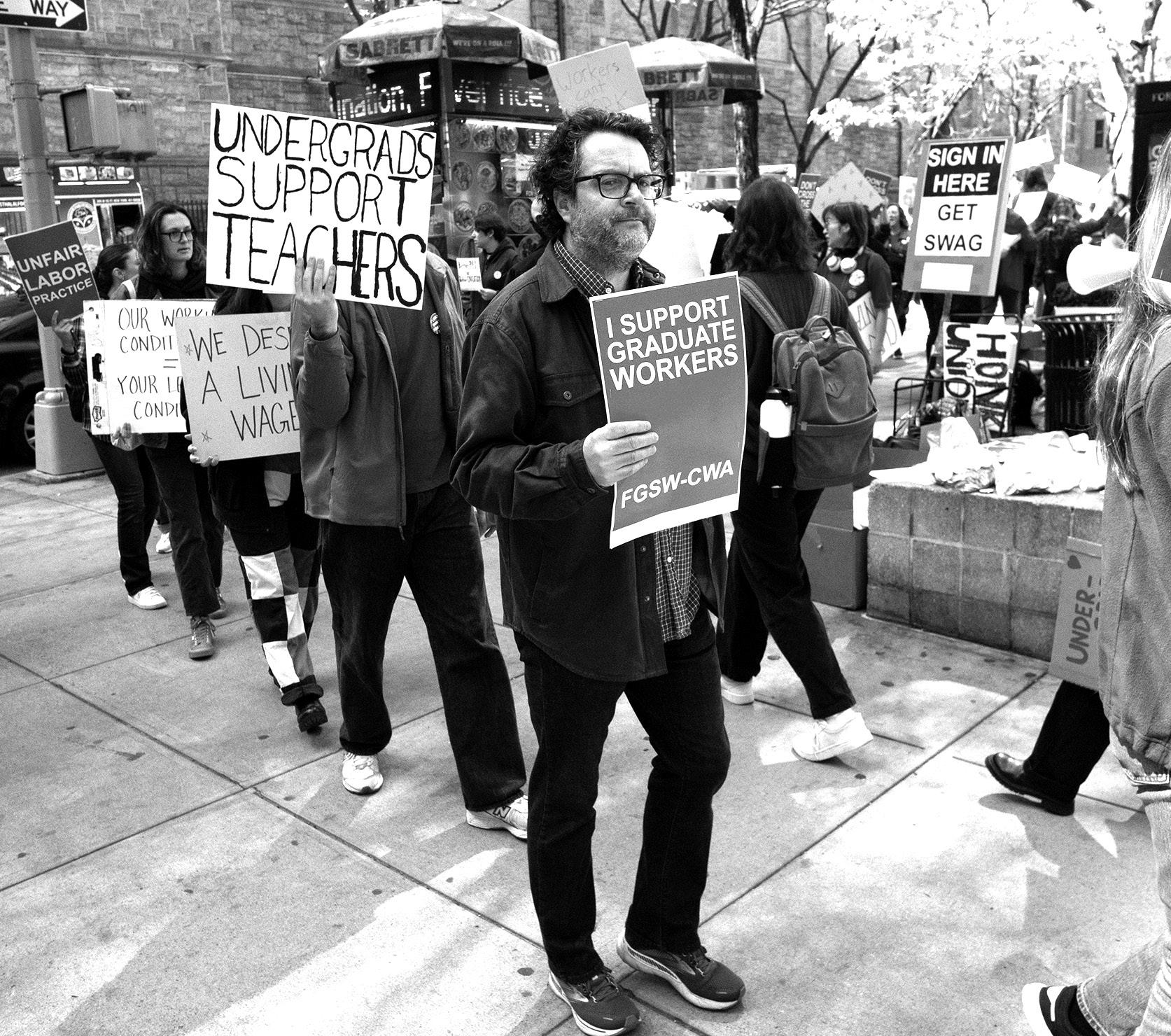
“The reason we’re learning anything that we are, it’s not the Fordham administration teaching us, it’s them. It’s the graduate students; it’s the teachers,” he said. “Those are the people that run this university.”
and teach classes at the university. The student workers commit to nine months of part-time work capped at 19 hours per week.
According to Tetlow’s email, the university generally offers doctoral candidates and master’s degree students in the humanities, social sciences and sciences full-tuition scholarships, health insurance supplements and stipends ranging from $26,567 to $32,902.
In FGSW’s summary of their proposal, the union is asking for a minimum stipend of $60,000 dispersed over 12 months instead of nine or 10. Other proposed benefits include campus parking passes for all graduate workers.
Tetlow claimed that the total for the demand for increased compensation and scholarships would exceed the top 20% of U.S. incomes, which is $130,000.
Carolyn Cargile, a doctoral candidate in English who was on the picket line on April 24, said that graduate student workers do a lot of work for the university while experiencing food insecurity, housing insecurity and more.
“The walkout is a way of telling the administration that our work is really integral to the mission of the university and that we deserve fair treatment and compensation,” Cargile said.
The union is also asking for more comprehensive benefits and protections for international graduate students, including “reasonable” paid time off for attending immigration proceedings, guaranteed housing, and a one-credit extended orientation course the summer prior to fulltime enrollment to support the process of visa and social security applications, housing and building a support network.
Amal Zaman, an international graduate student and member of the FGSW bargaining committee, explained that international student workers experience difficulties getting paid on time due to challenges with being able to quickly attain a social security number (SSN).
“The university does not utilize
in place of social security numbers,” Zaman said. “So international graduate workers are sometimes waiting for months to receive their SSNs and thus their compensation. The university has rejected our proposal which stated that the university will pay them on time by utilizing alternate identification.”
Other demands include guaranteed summer funding or employment, a legal assistance fund to support visa, tax and social security applications, and a housing guarantor subsidy to help students whose income may be insufficient to secure housing on their own.
Their proposal also outlines the prohibition of nondisclosure agreements, establishment of a childcare subsidy for those with children under five years of age, and work assignments communicated to graduate students no fewer than 10 weeks prior to their start date.
FGSW is also asking for changes to discipline and discharge standards, demanding that they should not be disciplined or let go without “just cause,” which would mandate that Fordham provide proof of a terminated worker’s conduct meeting the required standards for termination. Another demand is access to university-provided and funded resources like printing, laptops and teaching software.
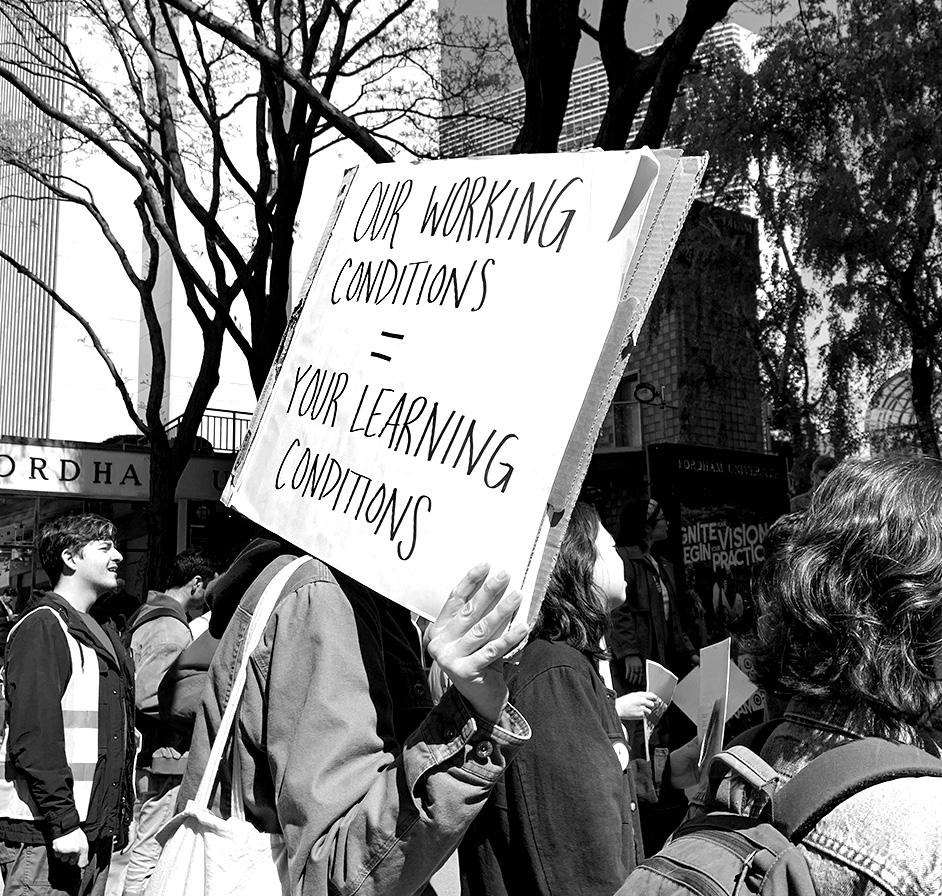
In her email to the Fordham community, Tetlow expressed that while the university understands the desire for a living wage, affordable housing and free childcare, Fordham is in disagreement with FGSW’s expectations.
“It would effectively require us to redirect the tuition dollars paid by undergraduates and other graduate students to provide full, personal financial support for the 360 students represented by this union,” Tetlow said.
Graduate student workers first approved a vote to unionize in April 2022 and sent a “demand to bargain” to the university on Sept. 6, 2022. FGSW and Fordham have been negotiating the first contract since October 2022,
and, as of March 27, they have held over 10 bargaining sessions.
Zaman explained that she would like to see Tetlow directly involved in the negotiations and feels that the union’s demands are not taken seriously.
“I would like to see President Tetlow at the table, engaged in good-faith bargaining, taking seriously the demands of hundreds of people as a starting point for problem-solving rather than her lawyer’s union busting and attempting to force a contract onto its workers that will worsen their conditions,” Zaman said.
Howe did not comment on the union’s specific demands or the university’s negotiating position.
“We are in active negotiations with the graduate student union and are optimistic we will reach an agreement,” Howe said. “You should know that it can take a year or more to negotiate the first contract with a new bargaining unit.”
FGSW and those in solidarity with the union will remain on the picket line until April 26, which Siebert encourages students to join. There will also be a closing rally held at the Rose Hill campus on April 26 at 3 p.m. to conclude the walkout.
“We’re really doing this to improve Fordham, and that includes the education of undergrads,” Siebert said. “A lot of what we’re asking for is so we can better educate at this university, because that is what we are paid to do.”
Insiya Gandhi and Jillian Arena contributed additional reporting to this story.
Graduate student workers develop research, provide research assistance and faculty support,
alternate ID and bank letters
Members of the union protested for two days and protested for three days in response to dissatisfaction with ongoing contract negotiations with the university
“ I think they attempted to portray (FGSW) as entitled and asking for things that are ridiculous. ”
Matthew Siebert, FGSW coordinating committee member
“ It would effectively require us to redirect the tuition dollars paid by undergraduates and other graduate students to provide full, personal financial support for the 360 students represented by this union. ”
FGSW from page 1 INSIYA
Tania Tetlow, J.D., University President
GANDHI/THE OBSERVER
FGSW is demanding an increase in wages and more support for international graduate student workers, as well as workplace protections.
“ We’re really doing this to improve Fordham, and that includes the education of undergrads.”
Matthew Siebert, FGSW coordinating committee member
AURELIEN CLAVAUD/THE OBSERVER
www .fordhamobserver.com THE OBSERVER May 3, 2023 News 5
Jeffrey Flynn, associate professor of philosophy, joined the picket line in solidarity with graduate student workers.
Sports & Health
Fordham Baseball Swept by Saint Joseph’s Over Weekend
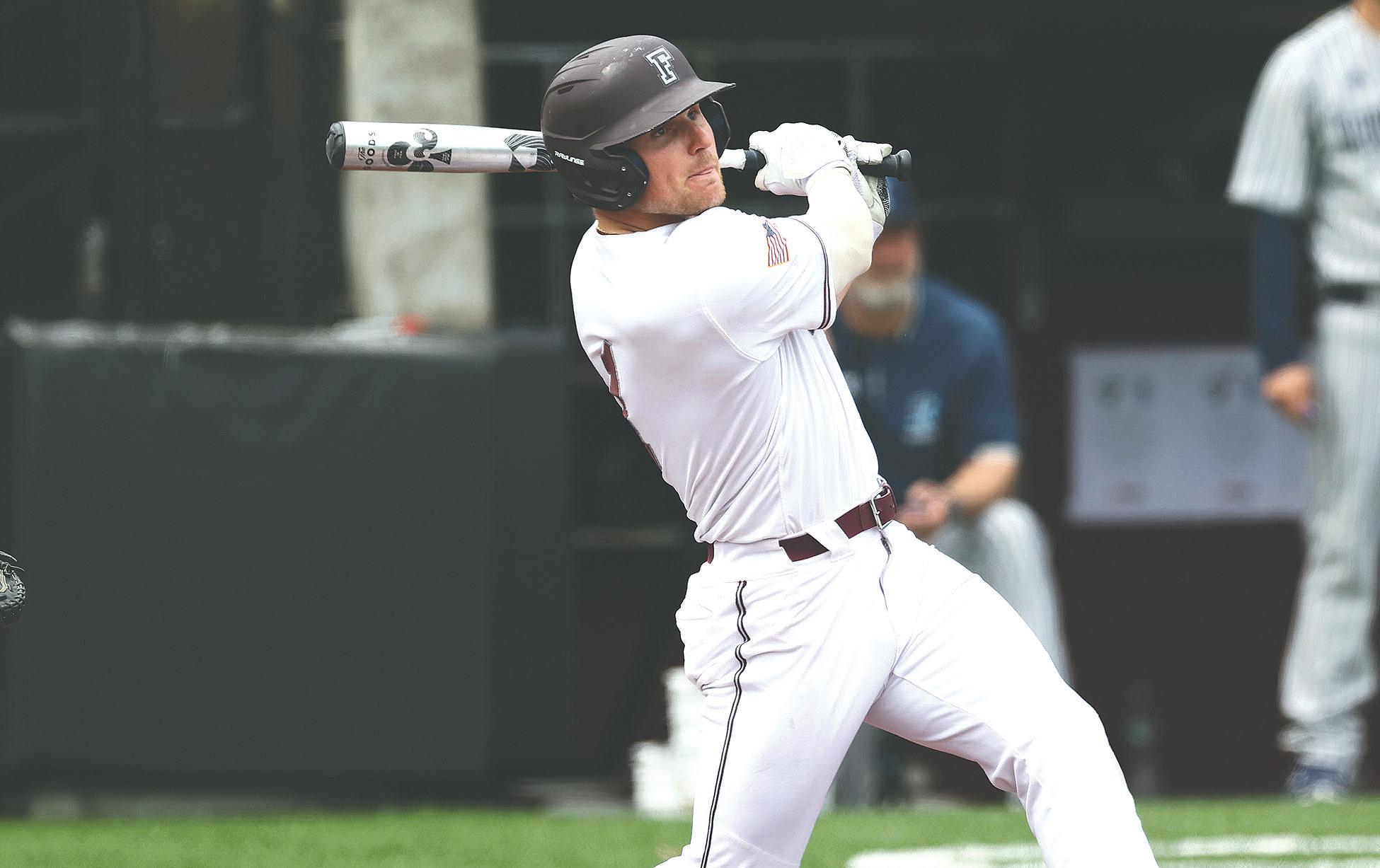
As their season enters its final stretch, the Rams failed to capture any momentum and lost three straight, bringing their losing streak to five
By CHRIS MURRAY Sports & Health Editor
With about a month left in the regular season, the Fordham baseball team headed down to Philadelphia on April 28 to take on the Saint Joseph’s University (SJU) Hawks. The Rams entered the series near the bottom of the Atlantic 10 (A10) standings but remained in the hunt for the postseason with numerous games against conference opponents ahead.
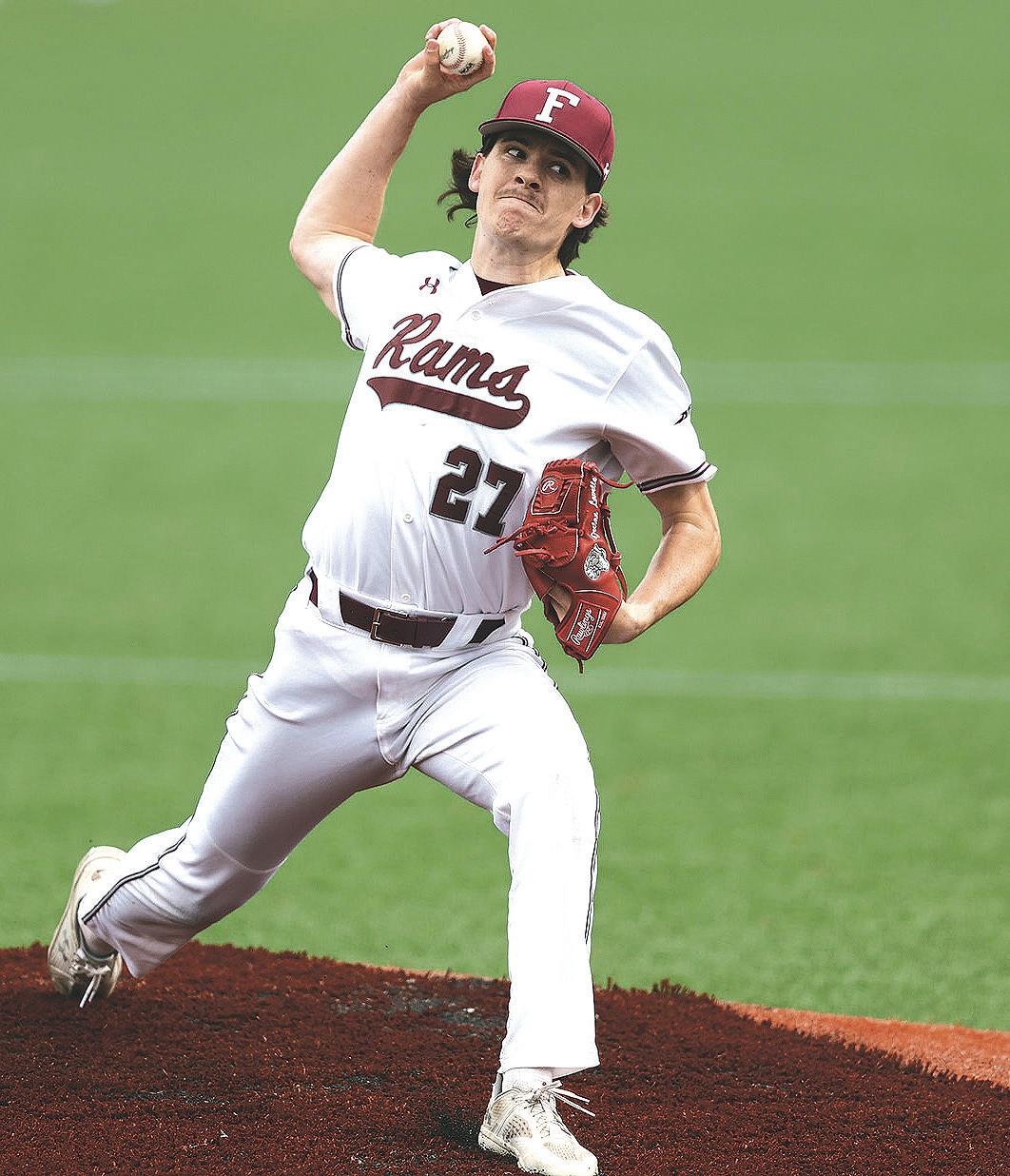
Unfortunately, Fordham lost all three games over the weekend and now faces an uphill climb as the season comes to a close. The series showcased a litany of different issues plaguing this year’s team.
The weather for the weekend was dreary, foreshadowing the gloomy play of the Rams. Friday’s game started with an optimistic spark. In the first inning, three singles culminated with Tommy McAndrews, Fordham College at Rose Hill (FCRH) ’26, driving in Ryan Thiesse, Gabelli School of Business at Rose Hill (GSBRH) ’24. McAndrews’ 27th run batted in of the year gave Fordham an early 1-0 lead.
The early game featured the most runs in any match Fordham has played this season.
After quickly jumping ahead, the pace of the game settled. Fordham’s starting pitcher, Declan Lavelle, FCRH ’24, delivered five innings of scoreless ball, striking out three Hawks in the process. Prior to this start, Lavelle had allowed at least two earned runs in each of his last five outings. This time around, he gave up only two hits in total.
Lavelle was replaced after five innings of work with Nolan Hughes, GSBRH ’24. The Hawks capitalized against the inconsistent lefty almost immediately. Facing his first batter, outfielder Brett Callahan, SJU ’24, pulled
a ball into right field and raced around the bases for a triple. A few batters later, Justin Igoe, SJU ’24, drove him in with a sacrifice fly — a fly ball that allowed the runner to tag up from third — to knot the game at one apiece.
When the Hawks came to bat in the bottom of the seventh, it was Callahan making something happen once again. After two consecutive singles, Hughes was lifted from the game in favor of Ben Kovel, GSBRH ’23. The switch proved ineffective as Callahan immediately singled to drive in what would be the game’s winning run. The Rams loaded the bases in the ninth but failed to cash in any runs and lost the opener of the series, 2-1.
On Saturday, the two teams geared up for a doubleheader in more somber weather. The early game featured the most runs in any match Fordham has played this season. Once again, the Rams got off to a hot start. Zach Selinger, FCRH ’23, smoked a three-run homer to put Fordham ahead in the top of the first inning.
The lead, however, would
not last for long. Saint Joseph’s scored seven unanswered runs, capped by a two-run home run by Luca Trigiani, SJU ’23, in the bottom of the third. Despite falling behind, the Rams refused to relent.
In the next half inning, Fordham’s bats put on a clinic. The inning featured four hits, a walk, three Rams hit by pitches, and six runs to put Fordham back in front, 9-7. Whatever momentum the Rams had built was promptly zapped the next inning.
The Hawks completed their sweep, and Fordham dropped to 3-9 in A10 play with nine conference games remaining.
The Hawks scored not four, not eight, but 12 runs in a monstrous single-inning offensive performance. At two separate points in
the inning, Saint Joseph’s strung together four consecutive hits. By the end of the onslaught, the Hawks had taken a comfortable 19-9 lead and drained the confidence that the Rams had built the inning prior.
Each team added some runs, and the final score ended up at 23-10. Fordham prepared for its second game of the day, facing a potential sweep at the hands of their intraconference opponent.
While the Rams had gotten off to prosperous starts in each of the first two games, Saint Joseph’s maintained control of the final game of the series throughout. After retiring Fordham’s first three batters in order in the top of the first, the Hawks scored four runs in the bottom of the inning.
Saint Joseph’s tacked on two more runs, one in the second and one in the fourth, extending its lead to six. The Hawks scored their final run of the game in the sixth when Ryan Cesarini, SJU ’25, smacked a double into left field and drove in his second run of the day. Meanwhile, Hawks starting pitcher, Domenic
Picone, SJU ’24, held the Rams scoreless through eight dominant innings.
The Rams would go on to plate a run in the top of the ninth but ultimately fell by a score of 7-1. The Hawks completed their sweep, and Fordham dropped to 3-9 in A10 play with nine conference games remaining.
For two games this series, Fordham’s batters uncharacteristically struggled. Additionally, Fordham’s pitchers allowed at least seven runs in two of the games, with one of the games featuring so many runs that a comeback by the hitters was virtually impossible. The Rams have now lost eight of their last 10 matches, with this recent slump coming at a pivotal moment for the team.
The Rams now find themselves second to last in the conference standings. Crazier things have happened, yet numerous things will have to break Fordham’s way for the team to find itself competing for an A10 championship this season.
One source of optimism may be that the Rams’ next seven games will be played at the Rose Hill campus. Competing in front of Fordham’s passionate fans may provide the jolt that this squad needs to make a run, leading up to the end of the regular season.
Fordham’s next conference series will begin on May 5 against the Patriots from George Mason University. The Patriots sit at exactly .500 in both conference play, as well as overall. A strong showing next weekend may be just what the Rams need to jumpstart their 2023 campaign.
 COURTESY OF FORDHAM ATHLETICS
Declan Lavelle, FCRH ’24, excelled in his start in the second game of the series with impressive records.
COURTESY OF FORDHAM ATHLETICS
Fordham baseball huddles before their first of three games in Philadelphia against St. Joseph’s University.
COURTESY OF FORDHAM ATHLETICS
Ryan Thiesse, GSBRH ’24, has had 177 at-bats this year, driving in 22 runs off of 50 hits.
COURTESY OF FORDHAM ATHLETICS
Declan Lavelle, FCRH ’24, excelled in his start in the second game of the series with impressive records.
COURTESY OF FORDHAM ATHLETICS
Fordham baseball huddles before their first of three games in Philadelphia against St. Joseph’s University.
COURTESY OF FORDHAM ATHLETICS
Ryan Thiesse, GSBRH ’24, has had 177 at-bats this year, driving in 22 runs off of 50 hits.
Numerous things will have to break Fordham’s way for the team to find itself competing for an A10 championship this season.
Sports & Health Editor Chris Murray May 3, 2023 THE OBSERVER
The End of an Era in the Bronx

Precipitous coaching changes and a full rebuild follow Fordham women’s basketball’s rise
“Before their season started, the kids reached out, and it was a tough situation for all of us,” Gaitley said. “Out of respect to them I stepped away.”
Many players who have grown to be Rose Hill superstars — Anna DeWolfe, Fordham College at Rose Hill (FCRH) ’23, and Asiah Dingle and Kaitlyn Downey, both Graduate School of Arts and Sciences ’23 — were developed under Gaitley’s program. Gaitley’s defensive-minded praxis, communication and culture-building were signatures of her coaching that helped the team become a contender in the conference. She had produced a sustainable program whose culture would attract talent.
“If I was there for five years, I believe (DeWolfe) would have stayed at Fordham,” Gaitley said. “The plan was for her to stay at Fordham — I saw her becoming the all time leading scorer. The future was bright.”
When Gaitley left, her shoes had to be filled quickly. In the immediate aftermath, it was obvious that a rebuild was in order. Candice Green, former assistant coach, worked alongside Gaitley and was given the title of interim head coach following Gaitley’s leave. While Green was offered an opportunity to apply for the full head coach position for the 2023-24 season, the message
from Fordham Athletics was clear: 2022-23 is the last dance.
“It was a shock for all of us. Coach Gaitley had built this family; we really loved each other,” Green said about Gaitley’s departure. “But we were taking the year (2022-23) as ‘Hey, it’s our chance to salvage this moment.’”
Green’s leadership in her lone season as interim head coach was emblematic of that attitude. Alongside Anita Jennings, Lauren Holden and Liz Brown — assistants under Gaitley who stayed with Green — the women’s basketball coaching staff led their players through increasingly tough competitions. Weathering injuries and setbacks, the Rams fought their way to the second round of the women’s National Invitational Tournament.
“We were just happy to win a postseason game, not too many teams get a chance to do that,” Green said about the Rams’ 73-63 win against Drexel University.
Before their second-round matchup against Columbia University, Green told her team with confidence that it didn’t have to be their last game. With eight seniors leaving, they had nothing to lose. The Rams, however, did fall in the end to Columbia 78-73.
As quickly as the year had gone, so had the coaching staff. In one fell swoop, Green and her assistants were let go at the conclusion of the 2022-23 season. The administration thanked the staff privately and in a Twitter post.
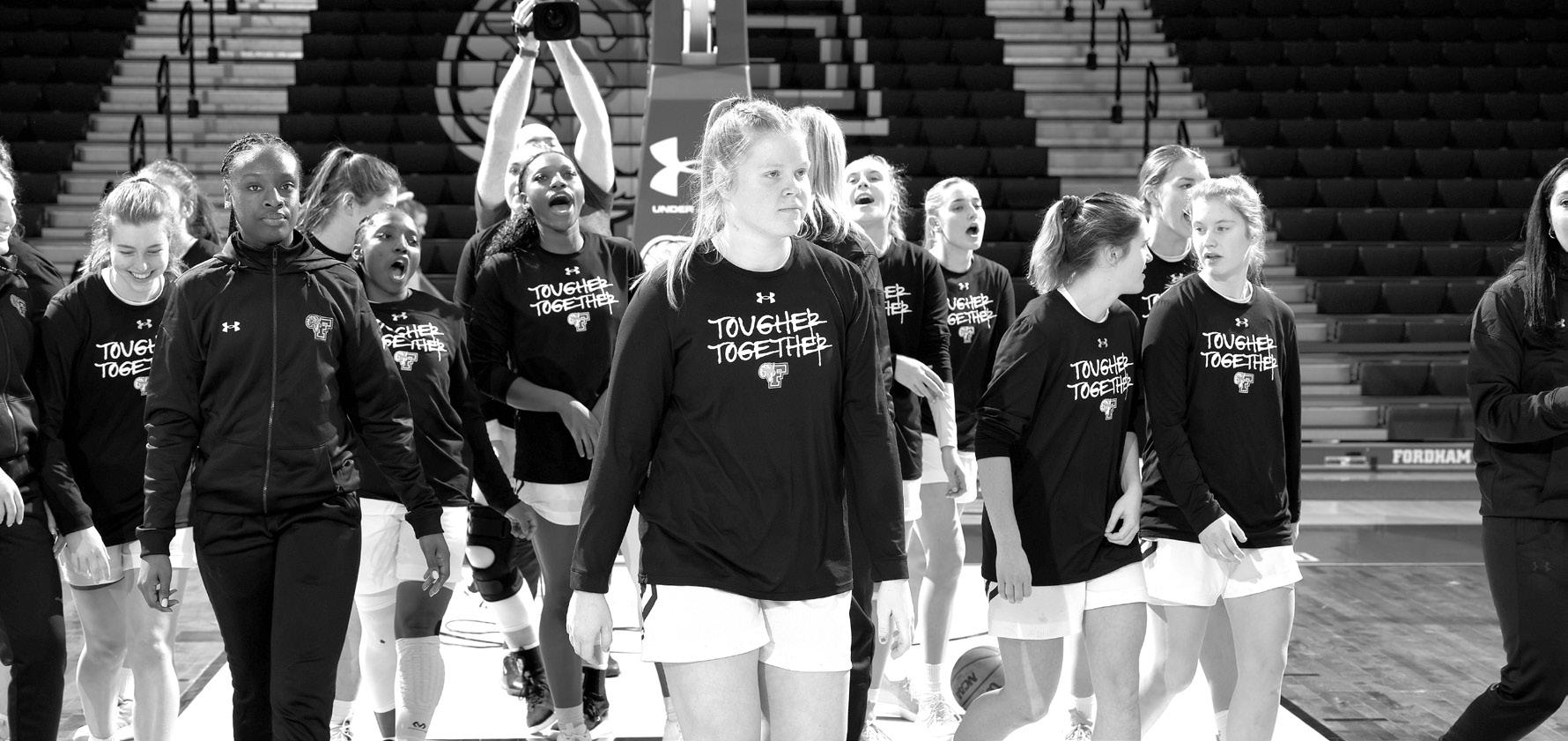
Ed Kull, director of intercollegiate athletics, was amicable and fielded a good relationship with the staff, according to Green.
“They wanted to go in a different direction, but I was grateful for the opportunity,” Green said. “Me and Ed have a great relationship.” But that wasn’t the end of the story. Chatter abounded, and soon DeWolfe, star shooter for the Rams, had accepted an offer and transferred to Notre Dame University. Those close to DeWolfe and the women’s basketball program were unsurprised, considering the future outlook of the team. Early on in the 2022-23 season, Green was made aware
that DeWolfe did not want to end her career at Fordham.
“She wanted to play for a team that could make a deep run in the tournament,” Green said. “She gave us four years of high-level basketball; we couldn’t fault her for taking the opportunity.”
Nevertheless, the timing is conspicuous. DeWolfe’s skills are evidently better served at Notre Dame, but to leave right as the program is being renewed is food for thought. When newly minted Head Coach Bridgette Mitchell arrived on campus from Northeastern University, everyone knew another change would come.
“From my understanding, half the team has already left,” Gaitley said, referencing the ever-active transfer portal. On Sunday, Colleen McQuillen, FCRH ’25, announced her transfer to Lehigh University, a fellow Atlantic 10 school.
For now, the only thing known is that the eight seniors left and two returning players have elected to transfer. It remains to be seen who will receive playing time and who will find themselves in the Bronx through the transfer portal next year, but it is clear that Gaitley’s era of basketball has finally ended, and Mitchell’s has just begun.
Women’s Tennis Wins A10 Championship
The team will face off against Princeton in the first round of the NCAA tournament
By AURELIEN CLAVAUD Creative Director
The Fordham women’s tennis team defeated the Virginia Commonwealth University (VCU) Rams on April 30 to win the Atlantic 10 (A10) Championship. It is the first championship win for the Bronx Rams since their 1990 Patriot League victory. The win breaks a four-year A10 championship winning streak for VCU.
Fordham was seeded second, and VCU was in first, but the New Yorkers had the advantage of a sixgame winning streak: a healthy momentum advantage. The Rams won two of three matchups to take the doubles point, 1-0. Valeriya Deminova, Gabelli Graduate School of Business ’23, and Avery Aude, Fordham College at Rose Hill (FCRH) ’23, took the second doubles 6-4, and Carlota Casasampere Escoda, Graduate School of Arts and Sciences ’23, and Rachelle Yang, FCRH ’23, fought for a 7-6(3) victory in third doubles.
The Rams took the third, fourth and fifth singles. Eleni Fasoula, FCRH ’24, defeated Victoria Matasova, VCU ’26, 6-3, 6-3 in third. Aude took down Gabriela Davidescu, VCU ’23, 6-2, 6-4 in fourth, and Escoda capped it off with a perfect straight set victory, going 6-0, 6-0 over Anja Drasovic, VCU ’25, in fifth.
When the final point was recorded and Fordham sealed the victory, the courts were rampant with emotion. Head Coach Michael Sowter was treated to a water cooler shower as the team celebrated the historic victory.
The NCAA tournament is the next step for Fordham, and the selection occurred on May 1. Fordham, with a 14-7 record, will
officially face Princeton University, who posted a 16-6 record. The Ivy League Champs, the Princeton Tigers, and the A10 Champs, the Fordham Rams, will meet on Friday, May 5, in the first round.
After a great year for the football, basketball, water polo and swim teams, the women’s tennis squad has now marked themselves as another successful and exciting program to watch in the near future. With three graduate students out of eligibility next year, however, the team may need to lean on its three younger stars, including Fasoula. For now, the players await the NCAA tournament with eager anticipation.
GAMES POINTS
Doubles
First: Fordham Win (6-4)
Second: VCU Win
Third: Fordham Win (7-6)
Singles
First: DNF
Second: DNF
Third: Fordham Win (6-3, 6-3)
Fourth: Fordham Win (6-2, 6-4)
Fifth: Fordham Win (6-0, 6-0)
Sixth: VCU Win
Final Score
Fordham - 5 VCU - 2
Fordham - 1 VCU - 0
Fordham - 3 VCU - 1 RAMS WIN
WOMEN’S B-BALL from page 1
COURTESY OF VINCENT DUSOVIC VIA FORDHAM ATHLETICS
The eight graduating players on the Fordham women’s basketball team helped carry the Rams to the NIT.
www .fordhamobserver.com THE OBSERVER May 3, 2023 Sports & Health 7
Visual Arts Department Presents Senior Showcase
The exhibit features work from several Lincoln Center seniors
By AIDAN LANE and ADITI PRAVEEN KARIYANAHALLI Former Features Editor and Arts & Culture Editor
Lincoln Center’s Ildiko Butler Gallery was full of excitement on April 13, as the visual arts department celebrated the opening of a new exhibit as a part of its rotating Senior Seminar Showcase. The gallery was a three-part exhibit that featured Slav Velkov, Bryson Kernan Clark and Anna Tatyana Koch, all Fordham College at Lincoln Center ’23.
The showcase was the product of projects from the fall 2022 senior seminar class, which had the goal of preparing students to present their artwork to the Fordham community across both the Lipani and Ildiko Butler galleries on a rotating basis throughout the spring 2023 semester.

Velkov, Koch and Clark’s artworks communicated their perspectives on life and society and complemented one another as they each discussed aspects of their projects.
“Zavet”
“Zavet,” is a charcoal and pencil drawing that offers a reflection on the finality and the limitations of familial and social bonds in a “Madonna and Child”-esque image. Velkov noted that he chose to work with charcoal because he wanted to place design and light at the forefront. “Color can sometimes be an easy way to attract the eye, and I wanted to grab the viewer only through light and shadow,” he said.
According to Velkov, the reason he chose “Zavet” to be the title of his work is because of the word’s

AIDAN LANE /THE OBSERVER “Elements From Home.”
PHOTO COURTESY OF SLAV VELKOV “Zavet.”
dual meaning in Bulgarian, which refers to ancestral heritage and a safe space from external forces.
At the center of “Zavet” is a despondent-looking mother and her young son in a seemingly protective bubble; however, they are surrounded by pressing, yet distant, specters of historical and artistic symbolism. (If you look close enough you might even see Donald Trump.)
Velkov mentioned that “Zavet” is as much of a personal reflection as it is an artistic and philosophical commentary on the necessity of structure. He added that his own experience of leaving his family in Bulgaria to study in New York informs “Zavet,” as does the highly politicized world that he’s grown up in, where ideas, concepts and families have been torn apart.
“There is something mysterious about art that I cannot fully explain. I have always been fascinated by achieving some sort of an ideal; building bridges from the quotidian to the divine, whatever the divine is,” he said.
Velkov noted that the inception of this painting originated from an emphasis on form and inspirations drawn from German expressionism and metamodernist thought. He added that the focus of the piece began with a central spotlight on “line, light and shape, rather than metaphorical meaning. I was thinking about proportion and symmetry.”
The artist behind “Zavet” hopes his piece will be defined by a “breaking-out” of the deconstruction of form which he feels characterized 20th century art. Thus, his work consists of a renewed focus on form.
“Familial severance is the force that breaks apart,” Velkov said. “But, the universality of that force is what keeps society together.”
“Passerby”
Like “Zavet,” Koch’s work, “Passerby,” ponders change but in a more familiar and grounded setting. It explores the ever-changing scenery of New York City through the perspective of her daily commute to the Lincoln Center campus on the BxM9 bus. Koch has envisioned and painted a series of works analyzing the old and new architectural landscape of New York City as she sees it.
In her paintings, Koch utilizes watercolor and India ink to offer a cut and pasted arrangement of recent architectural trends. Featured scenes include an old deli juxtaposed with a gentrified donut shop, as well as the recently closed Harlem Papaya King sharing a frame with a Chick-fil-A.
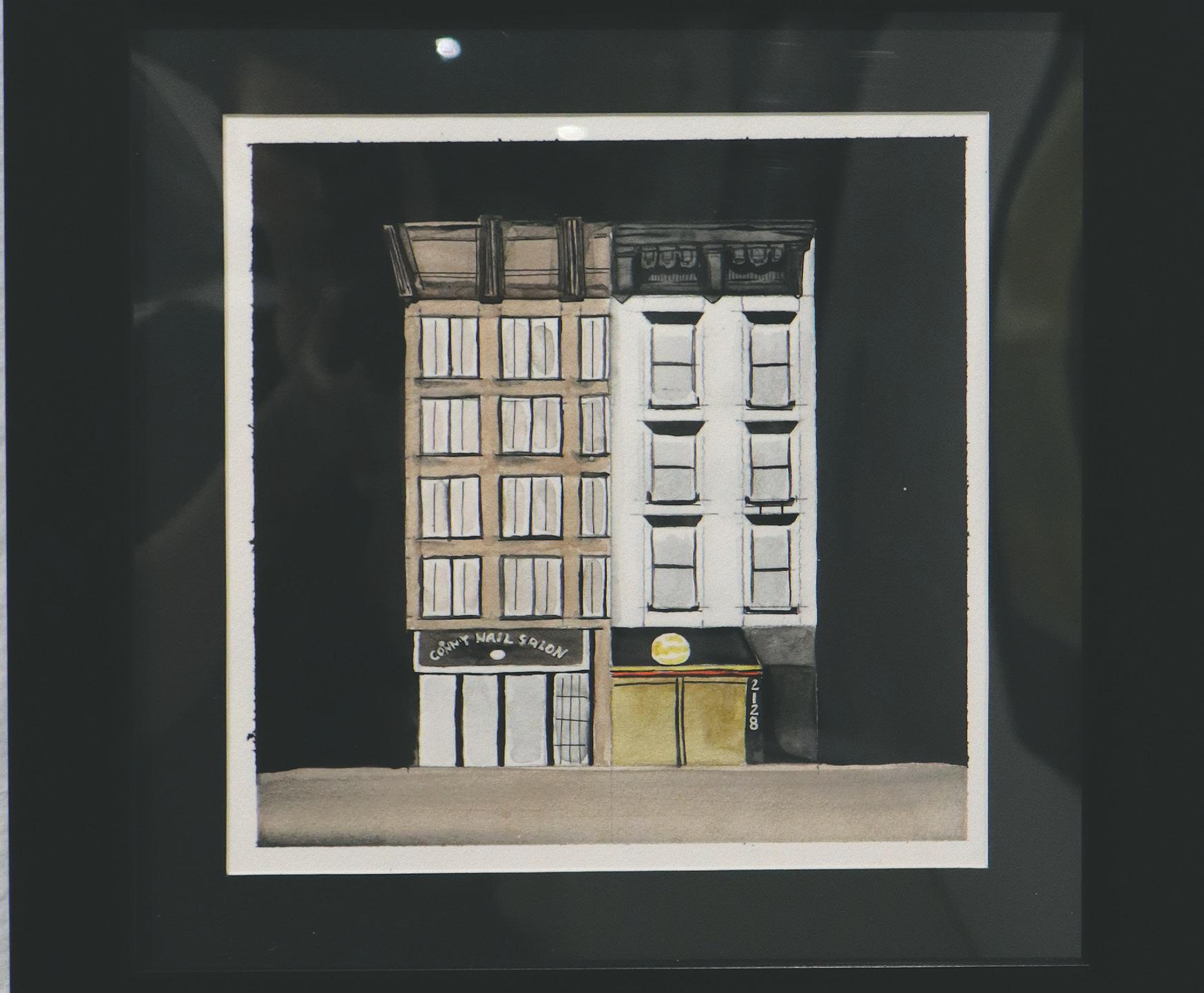
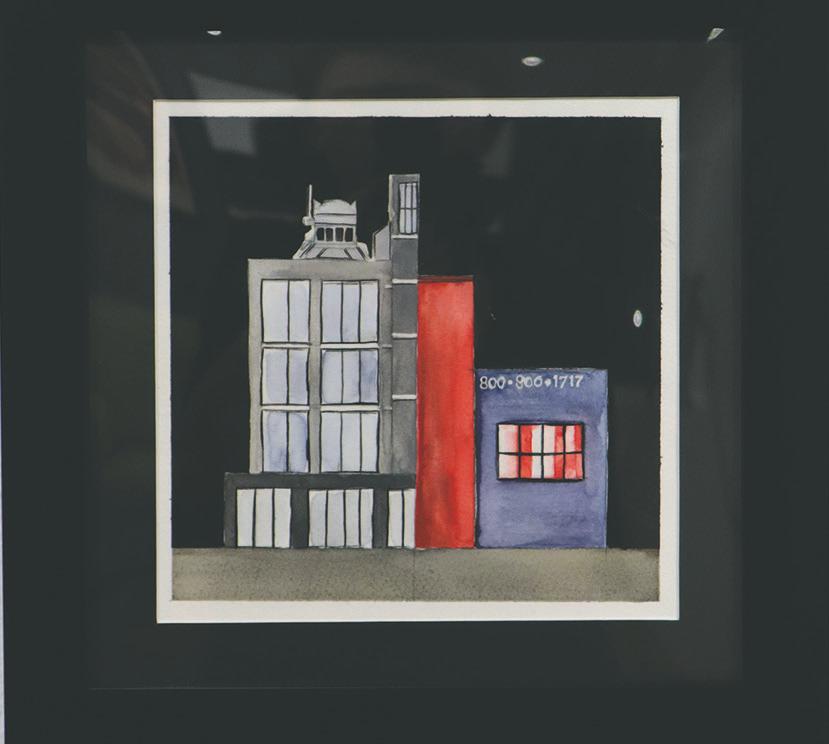

“A personal landmark, although not equivalent to a historical landmark, can hold a more profound significance for an individual,” she said.
Koch noted that for “Passerby,” she wanted to compare buildings she loved with buildings that she hated and paid attention to buildings that were constructed following brutalist post-war structure styles.
Throughout the process of creating “Passerby,” however, she grew to love each of the buildings she paid attention to on her commute, no matter if they were old or new. “When enough care is put into a building and structure, you
can always find things to appreciate about it,” she said.
Through this view, Koch too provides a reflective commentary on the constantly changing qualities of society, as well as the gentrification crisis plaguing neighborhoods across New York City. According to Koch, “Passerby” focuses on the individuals and emotions that are affected by the alterations made to a once-familiar city and said that she feels strongly that there are beautiful aspects to this city-study.
Koch noted that she wanted to deviate attention from traditional New York City skyscrapers and “focus on commercial mixed-use buildings” which would hone in on the ideas of personal and community landmarks over tourist landmarks. “I want people to look at their commutes and journeys and think about what they want from the structures in their communities,” she said.
“Passerby” serves to emphasize the beauty that an individual can find anywhere in their life, and especially during their morning commute.
While Velkov and Koch aimed their focus on outward societal developments, Clark looked inward and developed a still inspired by elements from his childhood home and current apartment. “Elements From Home,” according to Clark’s artist’s statement, is a testament to a “sense of aesthetics and a set of storied objects which can carry meaning through generations.”
According to the statement, most of the work is repurposed from furniture left on the street corners and sidewalks of New York City.
“Elements from Home”
In his mixed media artwork, Clark rejected “fast furniture,” the practice of incorporating inexpensive, short-term, disposable pieces. Instead, he favored an interior design philosophy that reflects the generational and individual history of the designer and owner, an act of embracing a more personalized form to decor.
Clark sought to design a space contrary to the “concrete jungle,” in which objects can do the “heavy lifting” in the expression of an identity that may be too complicated to phrase verbally. He explored how a space can note aspects of the designer that are both personal and profound. “Objects can speak a lot to memory and identity,” he said.
Together, these three artworks from Velkov, Koch and Clark reflect upon the bonds developed between people and their communities, as well as highlighting the personal experiences that inspired their creations. They present the transient qualities that both movement and stability bring to society and one’s personal life upon reflection, whether that be in the care and arms of one’s mother, through watching the city pass by on one’s morning bus commute or in one’s own living room.
Velkov, Koch and Clark’s joint exhibit was on display until April 30, but their artwork will return to be part of the Senior Seminar Showcase, which currently hosts a small piece of each graduating senior’s work at the Butler Gallery until the end of the semester.
AIDAN LANE /THE OBSERVER Selections from “Passerby.”
What Do Artists Owe to Their Fans?
Poor reception of Frank Ocean’s performance at Coachella demonstrates the harms in the capitalization of the music industry
WINSTON Asst. Opinions Editor
The Coachella Valley Arts and Music Festival in Indio, California, has been a contemporary American cultural staple since its inception in 1999. This year’s lineup was set to be one of the best: After a forced two-year hiatus due to safety precautions throughout the COVID-19 pandemic, the festival announced that Frank Ocean would finally be headlining the final weekend of Coachella.
Since the release of his second studio album, “Blond,” in 2016, Frank Ocean has veered away from the music industry and shifted his focus to the fashion industry. Fans of Ocean’s music have aired their disappointments with the artist on social media time and time again, especially when Ocean would tease new releases, only for them to be fashion-related and not music. The announcement that Ocean was playing Coachella, however, seemed to be indispensable proof that he was not done with his music career just yet.
Many fans were willing to spend large sums of money to see Ocean’s first live show in years: Tickets to Coachella averaged around $600 for a weekend pass this year, not including transportation and lodging near the festival. Ocean’s performance was highly anticipated by both fans at Coachella and fans at home tuning in to a livestream broadcast of the festival.
The explanations, however, could not quell the emotions of Ocean’s fans: They were disappointed and angry at the artist.
The first disappointment of Ocean’s comeback performance was the announcement that the artist would not livestream his set on YouTube. Coachella traditionally keeps a running broadcast for each stage at the festival, allowing fans worldwide who could not afford tickets or make the trip to experience the festival virtually. Canceling the livestream for Ocean’s performance meant it was essentially closed off to only those who could afford $600 tickets in addition to transportation and lodging costs.
According to attendees of the festival, the fiasco only escalated from there. Ocean was late to his set, played a few reworked versions of his older songs, and promptly left. His performance only lasted about an hour. Viewers at home were able to watch — in very poor quality — through a social media livestream set up by a fan in the crowd. The general consensus among viewers of the performance — both in-person and at home — was that Ocean’s show was disappointing and not worth the exorbitant price of Coachella tickets.
After the letdown, explanations began to arise for Ocean’s lackluster performance. Some said that he had broken his ankle and had to abandon his original concert plans, which allegedly included featuring ice skaters on an ice rink built onstage. Others claimed that the artist did not want to headline the second weekend of Coachella but was forced to follow through on a contract he had signed years ago, before the COVID-19 pandemic. Another theory emerged detailing that Ocean was grieving the loss of his little brother Ryan Breaux, who died in a car crash in 2020, as demonstrated by his emotional tribute regarding his late brother’s love for Coachella during his set. The explanations, however, could not quell the emotions of Ocean’s fans: They were disappointed and angry at the artist. Ocean ultimately pulled out of
the festival after the disastrous performance, citing a leg injury. His headlining slot at Coachella’s second weekend was filled in by Blink-182, who originally appeared as surprise guests during the festival’s first weekend.
The language surrounding Ocean’s failed performance was largely economic. Fans spoke about the show as though it were a product: It was unsatisfactory, and they expected remuneration for their loss. Fans claimed that Ocean owed a good performance to his fans due to the amount of money they spent on Coachella, and they wanted that money back.
This raises an interesting question: Does Ocean actually owe something to his fans? Or, more generally, do any musical artists owe anything to their fans?
Fans’ protests against Ocean are expressive of the commodification of art, a characteristic of late-stage capitalism — a term that touches on the consumption of immaterial dimensions, such as art, in addition to material products. If an artist’s performance is deemed a product, it is only natural that it is spoken about in terms of satisfaction and payment in exchange for services. Viewers of performances think of themselves as customers rather than participants in an artistic experience.
Is this an adequate view of consuming art? Another comeback act at Coachella 2023, Jai Paul, offers a contrast to Ocean’s fiasco.

Paul was a rising star in the music industry when his unfinished debut album was leaked on the internet in 2013. In response, Paul dropped off the face of the earth. Despite the buzz surrounding him as an emerging artist, he refused to work on new music and made every effort to erase any trace of the leaked tracks.
After a few years, Paul eventually uploaded his still-unfinished tracks on streaming platforms, finally taking ownership of his music and allowing himself to profit monetarily off of his previously stolen cuts. Other than the surprise release of two singles in 2016, he had hardly been heard from until news broke that he would be performing at Coachella 2023.
Fans were ecstatic that they would finally be able to hear an artist who they had long assumed had quit the music industry. Paul’s comeback performance was met with acclaim and excitement for what was to come for the artist. Fans of his were genuinely happy to see him on stage for the first time, moving past the hardships he faced in entering the music industry and reigniting a career that could have been. Paul’s fans did not demand a return from him: Paul returned on his own terms when he was ready to start releasing music again.
The public receptions of Paul and Ocean’s comeback announcements were starkly different, despite the two artists’ similar positions as returning pioneers
of contemporary popular music. The difference can be explained by discrepancies in the two artists’ levels of notoriety and resulting position in the music industry.
Although Paul was immediately critically acclaimed upon his entrance into the music world, he has not reached anything close to the level of global fame that Ocean has achieved. Ocean has a large and dedicated fan base, fomented by his abundant catalog of released music and reputation as a titan of pop music. Paul, though he has a niche, is widely unknown by most casual listeners of music.
As artists grow more significant in popular culture, they quickly become more and more profitable. This makes them more of a focal feature in the music industry, which commodifies acts in order to make the maximum amount of profit.
The treatment of music as a commodity, rather than an art, also extends to fans. Fans begin to conceptualize their relationship with the artist as a transactional one, instead of a relationship rooted in emotional connection through art. Fame robs artists of the personal aspects of their performances; fans feel that they have the right to demand more music and better performances from their favorite artists because they’re the ones who are supporting and allowing them to make money off their art.
There is no real difference between Paul and Ocean. Both are artists who have left the music industry due to personal reasons and sought to return, in some capacity, at Coachella 2023. The anticipation of both artists’ performances, however, was starkly different due to their positions in the music industry hierarchy. Since Paul is relatively unknown, his performance was low-stakes and ended up reaping rewards and high praises. Had Paul’s performance gone wrong, similarly to Ocean’s, he likely would have been met with more understanding. Considering Ocean is a household name, his fans expected a much more impressive concert from him and had little empathy for him when it did not go according to plan. The emotional weight that most fans put on Ocean’s return ultimately culminated in great disappointment.
Art is a personal experience and cannot be quantified by ticket prices. Although it is understandable that fans are let down by what transpired during Coachella, Ocean does not owe anything to his fans. Just as Paul chose to come back to music at Coachella, Ocean made a personal decision to perform at Coachella and later pull out when he realized he would not be able to do justice for his fans. While this is a disappointment, his individual choices concerning his art should be respected. Artists do not owe their fans anything, but fans, at the very least, owe their favorite artists empathy.
the same individual on one topic. The Observer reserves the right to edit all letters and submissions for content, clarity and length. Opinions articles and commentaries represent the view of their authors. These articles are in no way the views held by the editorial board of The Observer or Fordham University. The Editorial is the opinion held by a majority of The Observer’s editorial board. The Editorial does not necessarily reflect the views held by Fordham University. To reach an editor by e-mail, visit www.fordhamobserver.com
The Observer is published on alternate Wednesdays during the academic year. Printed by

POLICIES AND PROCEDURES No part of The Observer may be reprinted or reproduced without the expressed written consent of The Observer board. Letters to the Editor should be typed and sent to The Observer, Fordham University, 140 West 62nd Street, Room G32, New York, NY 10023, or emailed to editor@fordhamobserver.com. Length should not exceed 200 words. All letters must be signed and include contact information, official titles and year of graduation (if applicable) for verification. If submitters fail to include this information, the editorial board will do so at its own discretion. The Observer has the right to withhold any submissions from publication and will not consider more than two letters from
Five Star Printing, Flushing, N.Y. Observer the Editor-in-Chief Maryam Beshara Managing Editor Ana Kevorkian Deputy Managing Editor Erika Tulfo Online Editor Quincy Reyes Creative Director Aurelien Clavaud Layout Editor Alyssa Shonk Asst. Layout Editor Giada Evangelista Head Copy Editors Smile Butt Grace Ehle Asst. Copy Editor Emily Davis News Editors Insiya Gandhi Alexa Villatoro Asst. News Editors Stevie Fusco Gabriella Gutierrez Sports & Health Editor Chris Murray Opinions Editors Jake Eraca Matthias Lai Asst. Opinions Editors Avery Grafeld Ana Winston Arts & Culture Editor Aditi Praveen Kariyanahalli Asst. Arts & Culture Editors Julia Jaramillo Juliana Sharon Features Editors Lola Cravath Madeleine Signore Asst. Features Editor Caroline Sensenig Social Media Editors Eeshita Wade Shelby Williams Multimedia Editors Lauren Bocalan Maria Terzulli Asst. Multimedia Editor Riley Kraus Podcast Host Morgan Johnson Podcast Producer Nellie Podokshik Editorial Adviser Richard Rosen Visual Adviser Jessica Green
GRAPHIC BY AURELIEN CLAVAUD/THE OBSERVER
Opinions Opinions Editors Jake Eraca Matthias Lai May 3, 2023 THE OBSERVER
ANA
Uganda’s
BENAËLLE BENOIT Contributing Writer
The Ugandan parliament passed an anti-gay bill on March 21 that introduces the death penalty for “aggravated homosexuality,” a broad term that criminalizes same-sex acts with children, people with disabilities, serial offenders, or people who test positive for HIV. It also prohibits an individual from identifying as gay or queer and bans organizations from requesting donations to advocate for LGBTQ+ rights. The bill finds those organizations guilty of promoting homosexuality, which is punishable by up to 20 years in prison.
Although this bill was passed in Uganda, it has a direct effect on African international students at Fordham and other universities who identify as LGBTQ+.
While Uganda is one of 30 African countries that has banned and criminalized samesex acts, this new legislation takes consequences to a greater level. It could potentially set a precedent for other African countries to follow, which could be devastating for the global LGBTQ+ community. It was described as “one of the most

A Death Sentence for Identity
extreme new anti-LGBTQ+ bill
extreme actions taken against the LGBTQ+ community in the world” by Karine Jean-Pierre, White House press secretary.

It is important that a culture of inclusivity and acceptance is promoted at universities across the United States, including Fordham.
Although this bill was passed in Uganda, it has a direct effect on African international students at Fordham and other universities who identify as LGBTQ+ and who may have to return to their home country depending on the validity of their visa status and individual circumstances. As a result of this bill, students returning to their home countries could legally face persecution and discrimination for their sexual orientation or gender identity.
The enactment of this bill also raises critical questions about how universities can support and protect students who identify with the LGBTQ+ community, especially those from countries with anti-LGBTQ+ legislation. Following the enactment of the bill, it is important that a culture of inclusivity and acceptance is promoted at universities across the United States, including Fordham. Protecting students from countries with anti-LGBTQ+ legislation would require steps
impacts international students in the US
and resources that are specific in addressing the needs of LGBTQ+ students of color.
At Fordham, Counseling and Psychological Services provides both general counseling services and specific health and wellness resources for students of color. In addition, the university offers a weekly “LGBTQIA+ Support Space,” but in this context, the resource could be improved if it was tailored for students from countries with anti-LGBTQ+ legislation. While Fordham does offer support for international
students as they navigate the visa application process, students have expressed frustration with the quality of services provided. In addition to improving those services, Fordham should advocate for international students’ rights and safety by working with other universities and organizations to raise awareness about the challenges LGBTQ+ students face in countries with antiLGBTQ+ legislation.
It is important that action is taken to support and protect these students. By providing
SUMMER LEARNING AT FORDHAM Register now via my.fordham.edu.

FEATURING
More than 350 core and elective courses
Daytime, evening, online, and hybrid options
Internship and practicum opportunities
On-campus housing
SESSION I: May 30–June 29
resources and safe spaces, offering legal and immigration support, and collaborating with LGBTQ+ organizations and activists, universities can create a culture of inclusivity and acceptance that extends beyond their campus borders — providing a lifeline for students who may feel isolated and alone. Only through a collaborative effort can we ensure that all students, regardless of their sexual orientation or gender identity, are safe and uplifted in their pursuit of education and personal growth.
SESSION II: July 5–August 7 (undergraduate)
August 8 (graduate)
SESSION III: May 30–August 7
For course descriptions and special program information, visit fordham.edu/summer.
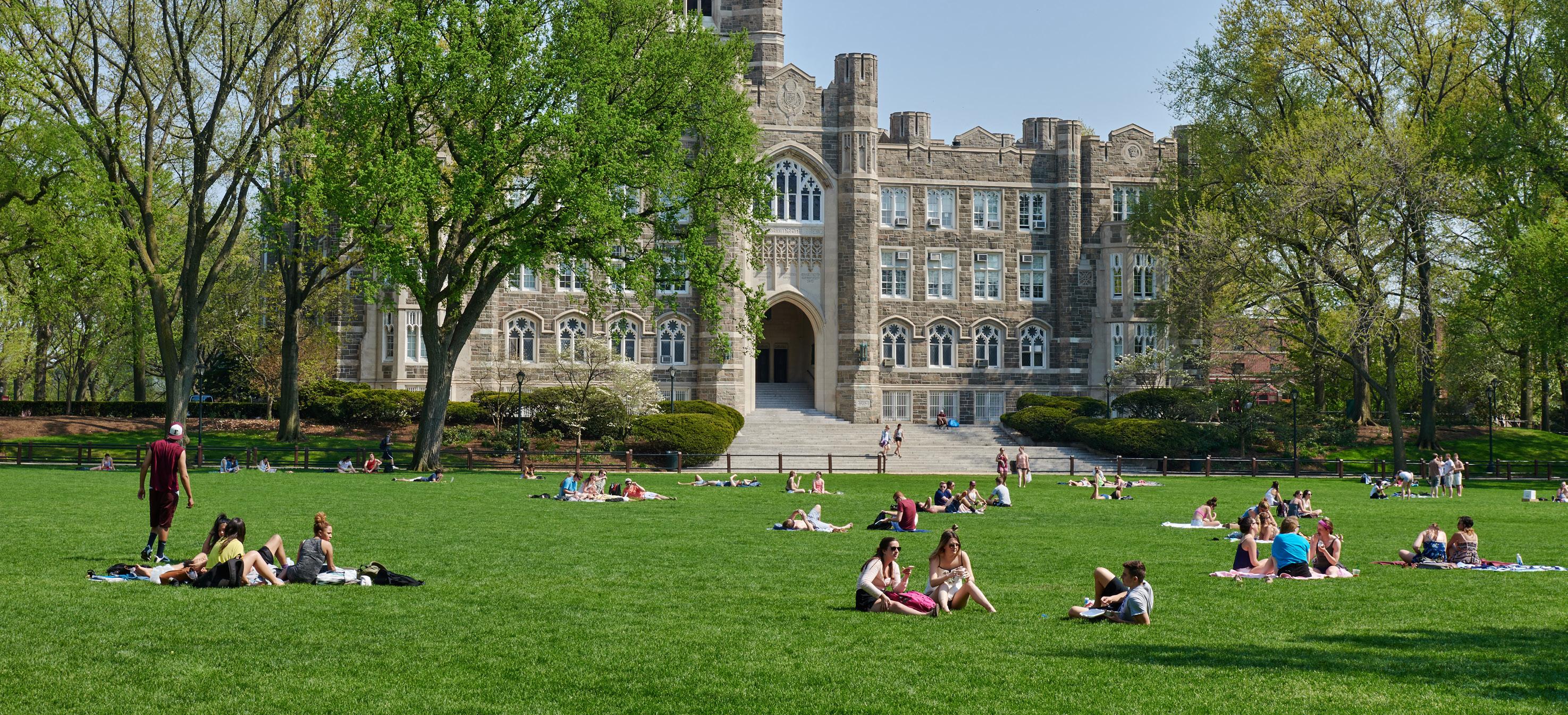 GRAPHIC BY AURELIEN CLAVAUD/THE OBSERVER
GRAPHIC BY AURELIEN CLAVAUD/THE OBSERVER
DISCOVER
www .fordhamobserver.com THE OBSERVER May 3, 2023 Opinions 11
Fordham Should Do More To Support Black Students
Ralph Yarl, a 16-year-old Black high school student, was shot by Andrew Lester, an 86-yearold white homeowner, in the Northland neighborhood of Kansas City, Missouri, while attempting to pick up his younger twin brothers on April 13. The unarmed teenager intended to meet his siblings at a home on 115th Terrace, but instead, he accidentally went to 115th Street. After the homeowner saw Yarl approach his home and ring the doorbell, he shot the 16-year-old once in the head, then again in the arm when Yarl was on the ground, according to Yarl’s aunt who discussed the details in an Instagram video.
not guilty to the charges. Civil rights attorney and lawyer for the Yarl family, Lee Merritt, said that the shooter was released in less than two hours after providing a statement to the police and posting his bail of $200,000.
When I learned of the shooting, all I could think was “Here we go again.” Yarl’s story parallels that of countless Black men who have faced violence by their white counterparts, such as Ahmaud Arbery and Daunte Wright — both of whom were fatally shot and received justice only after the public called for it — just to name a few.
counterparts due to hatred and contempt. It feels as though every day I hear a new story about someone who could’ve been my father, sibling or cousin facing violence simply because of the color of their skin. It is terrifying to reflect on a canvassing job I turned down last summer, for which I would have had to go door-to-door and to know that I could have suffered a fate similar to Yarl.
unlucky when shot by George Zimmerman as he was walking to his father’s house from a nearby gas station in Sanford, Florida? Was Philando Castile unlucky when he was shot by Jeronimo Yanez in front of his girlfriend and 4-year-old daughter in St. Paul, Minnesota?
Yarl spent three days in the hospital before leaving to recover in the comfort of his own home under the care of family members who are also trained medical professionals.
Lester was charged with first-degree assault and armed criminal action on April 17. He turned himself in to authorities on April 18 and pleaded
White perpetrators of crimes against Black men are often allowed to live peacefully until public attention takes over and calls for accountability dominate the cultural discourse. If Lester were Black, he would not have been able to peacefully turn himself into the police, let alone be released in less than two hours after providing a statement. Instead, he likely would have faced violence from authorities and been treated as a criminal. Justice isn’t always achieved, and the Black community is forced to continue to exist under a system that doesn’t work to protect it.
As a young Black woman, it is suffocating to repeatedly see people who look like me attacked and dehumanized while little is done about it. Since America’s founding, Black people have been criminalized and subjected to brutality at the hands of their white
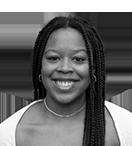
Recently, while reading updates about the news in between class discussions, one of my white classmates glanced over my screen and inquired about the details of the shooting. As I started to recount the reports, he reacted as if I was sharing a story about something embarrassing that had happened to me.
The Class of 2026 is Fordham’s most diverse yet, but there is a substantial amount of progress to be made.
to students of color and promote inclusivity. Aside from first-year orientation, however, I’ve only encountered OMA a limited number of times when members of their office presented at club meetings I happened to attend. Even then, it was the same recycled presentation about implicit bias that I’ve heard too many times to count. If my clubs hadn’t invited OMA to speak, truthfully, I wouldn’t remember that the resource existed.
“Oof ... unlucky,” he uttered. Unlucky: the word used to describe a traumatized, unarmed Black child who had been shot twice for ringing the wrong doorbell. Was Breonna Taylor unlucky when she was shot while sleeping in her home by police officers executing a “no-knock” search warrant in Louisville, Kentucky? Was Trayvon Martin
Throughout the majority of my academic career, I’ve attended predominantly white institutions and have become accustomed to being the only Black person in most of my classes. My classmate’s trivializing comment transported me from my American studies class to my former high school in Washington and has acted as a reminder that, no matter what, non-Black people will never see the world in the same way that we do.
My mind swirled with the microaggressions and blatant ignorance I have had to frequently experience throughout my life. My high school can be described as “liberal to a fault.”
The white students loved to boast about their activist mindsets and knowledge of social justice issues, yet they failed to acknowledge their positions of privilege. They neglected to learn how to be true allies to underrepresented communities and, in doing so, directly harmed the few Black students they encountered by alienating them.
The district enjoyed showcasing the influx of new students, especially those who weren’t white, in an attempt to come across as a welcoming and diverse institution. However, it failed to actually offer resources and approach nonwhite students with care. Rather than creating a safe space for students of color, it created a place of security for white students to exist in their privilege and remain oblivious to the reality of the struggles that Black Americans face.
Here I am, still one of the few Black students in my classes, in a space where there are few Black professors and limited faculty who would holistically understand my frustration, should I express it to them. As a sophomore, I still feel socially isolated in a space where I expected to thrive due to Fordham’s location at the heart of New York — one of the most diverse cities in the world.
While the university has advanced its diversity, equity and inclusion efforts since announcing an action plan to address racism in 2020 following the murder of George Floyd and the resurgence of the Black Lives Matter movement, Fordham is not doing everything it can to foster inclusivity across its campuses. The university highlighted its efforts to improve diversity, but few examples can be seen in action. The class of 2026 is Fordham’s most diverse, yet there is still a substantial amount of progress to be made.
The Office of Multicultural Affairs (OMA) exists at both the Lincoln Center and Rose Hill campuses to provide resources
In terms of education at Fordham, coursework promoting anti-racist ideology has not been easily accessible for Lincoln Center (LC) students. The majority of classes related to race and social justice are offered at Rose Hill, requiring LC students to accommodate their schedule around a cross-borough commute to the other campus. If you asked me to tell you about classes I could take at LC that would help me learn more about the Black experience, I wouldn’t be able to. It would be even harder to think of courses with multiple sections at LC that are taught by Black professors.
Fordham needs to do better if it wants to grow the enrollment of Black students who choose to attend the institution. Using images of Black students on the website at every opportunity to promote the university’s diversity is not the way to acknowledge our existence. The administration must be willing to listen to students who know best what can be done to make them feel comfortable on campus.
For me, a start would be addressing violence against Black people and other nonwhite communities immediately as it happens and offering support to affected students. The last university-wide communication regarding a racially motivated incident was shared on May 15, 2022, after the Buffalo supermarket shooting. While an email from former Senior Vice President for Student Affairs Jeffrey Gray addressed the murder of Tyre Nichols, the school has neglected multiple attacks against Black people this year. Keenan Anderson and Darryl Tyree Williams were also Black victims of police brutality this year, yet the school has not publicly recognized their deaths.
Fordham selectively chooses which initiatives to promote and garner support for, failing to address ongoing issues that directly affect the lives of its students. The school fails to fully use its platform to advocate for its Black students by speaking out against racially motivated attacks. The university needs to wake up and understand that its silence is an act of compliance with the system that fails to protect Black people, including its own students.
While nominally increasing diversity among the student population is important, it is equally important to put underrepresented students at the forefront and support their well-being. Fordham must do better to foster an environment where Black students feel seen and aren’t alienated by other students’ ignorance.
In order to best serve its students and create a comfortable space for them, Fordham needs to actively, vocally condemn violence against Black people as it happens and commit to encouraging its community to embody anti-racism.

Yarl’s shooting is yet another moment where Black people are forced to face the ignorance of their white counterparts
No matter what, nonBlack people will never see the world in the same way that we do.
GRAPHIC
OBSERVER
SHELBY WILLIAMS Social Media Editor
BY TARA LENTELL/THE
12 Opinions May 3, 2023 THE OBSERVER www .fordhamobserver.com
When I learned of the shooting, all I could think was “Here we go again.”
Arts & Culture
‘Camelot’ Is a Timeless Tale
Aaron Sorkin’s revision of the Lerner and Loewe classic successfully revives the medieval musical
By AVERY LOFTIS Former Asst. Arts & Culture Editor
For centuries, the legend of King Arthur has enchanted audiences worldwide. From books, to plays, to films, to TV shows, the tale has been adapted and re-adapted. The 1960 musical adaptation of “Camelot” by Alan Jay Lerner and Frederick Loewe opened in its latest revival on April 13 at the Lincoln Center Theater.
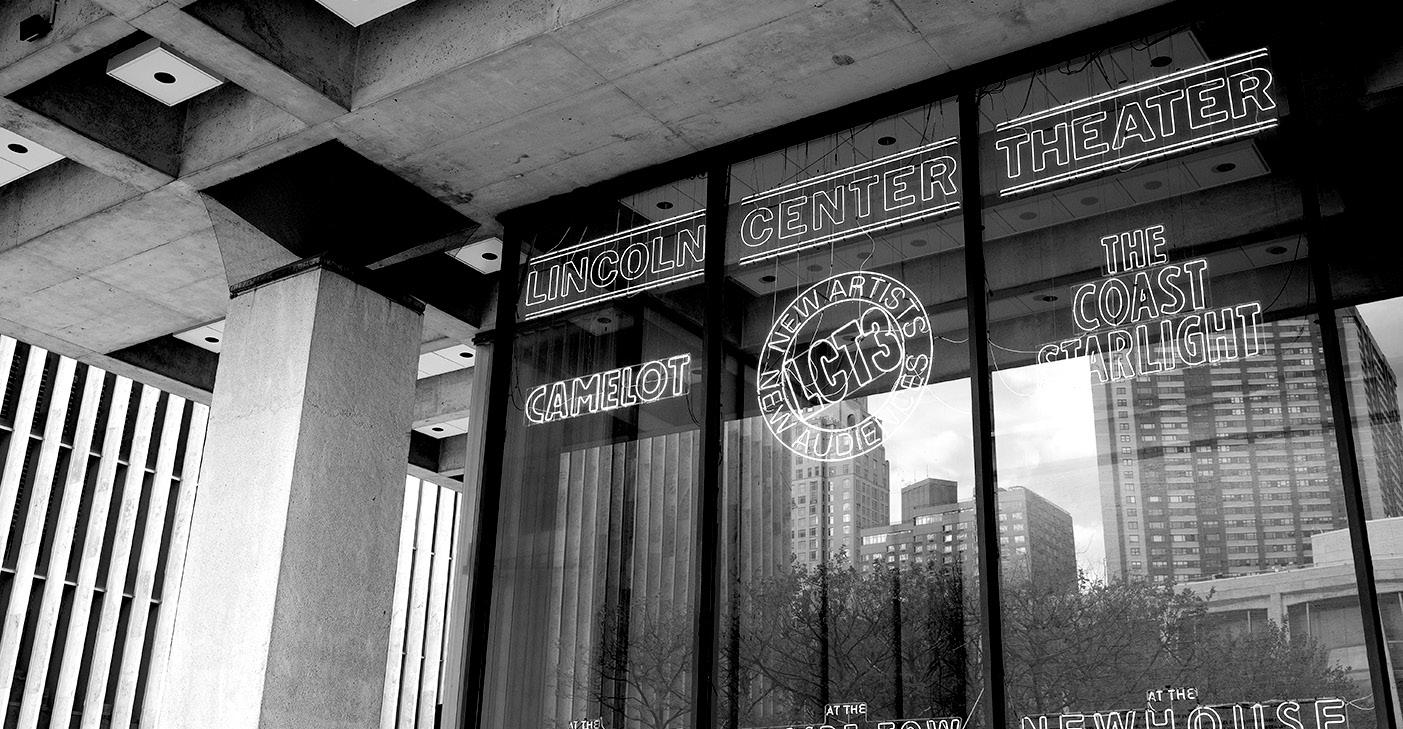
“Camelot” first debuted on Broadway over 60 years ago, but Aaron Sorkin’s revised 2023 rendition speaks to a global desire for peace and equality. Its plot resolves with a continual thread of hope that can’t help but make the audience feel a desperate sense of optimism.
Most of “Camelot’s” strength originates in the balance between bubbling wit and weary love and war.
In “Camelot,” King Arthur (Andrew Burnap) strives to achieve justice, peace and equality and lead his citizens by these principles. The first step to creating a peaceful Camelot is a marriage alliance between Princess Guinevere of France (Phillipa Soo) and King Arthur. Guinevere wishes to be a free woman, but when encountered with Lord Lancelot (Jordan Donica), who ventures to Camelot to join King Arthur’s knights of the
roundtable, her loyalties to her king and crown are tested, along with the ideals of the roundtable.
King Arthur charms Princess Guinevere with a song about Camelot’s weather — “Camelot” — and evident perfection. Again, King Arthur speaks to the precarious control he holds over Camelot and Burnap to the power “Camelot” has on stage.
Princess Guinevere realizes this plea for help after Merlin, King Arthur’s adviser, abruptly dies, while King Arthur also appeals to all “Camelot” has to offer in the means of adventure and “happy ever-aftering.” Thus, Princess Guinevere becomes Queen Guinevere, more of a “business partner” to King Arthur, helping him to strategize the roundtable and a just Camelot.
Burnap and Soo have a palpable onstage chemistry that carries the story. Despite playing the wife of King Arthur during medieval times, Soo is able to contrast the time period with Guinevere’s more contemporary independent fervor in tandem with humor and intellect, carefully entwined into the love triangle and political tensions within “Camelot.”
Soo’s character is one that transcends generations — invigorated with a liveliness evident in moments such as “The Lusty Month of May,” where she traipses around swaying with citizens of Camelot of all standings. Her flowy, off-the-shoulder, peony-pink dress and jewel-toned velvet ensembles throughout the show (designed by Jennifer Moeller) flaunt Queen Guinevere’s
multidimensionality and her rightful place leading a kingdom as she is the brains behind the king. Soo’s Queen Guinevere highlights an unequivocal regard for freedom and fairness; she presents her character with formidable power that matches her vocal range.
Sorkin’s rendition of “Camelot” enlightens a desperate hope for a society led with strength and justice in mind, by a man who wants to wield power in a just way that may not be possible without delving into corruption and danger. Burnap portrays Arthur as a character that is true to the young king that he is. Queen Guinevere continuously humbles him to be simply a man who had a sword in a stone loosened by 9,999 people before him.
Burnap’s attractiveness undoubtedly adds to his suitability for the role and privilege to determine an uncorrupted future, despite his fumbling mistakes. My personal judgment of his performance is clouded, but his devotion to Soo was not clear enough in his mannerisms. For a stereotypical white hero, situated to save the world (Camelot) and to get the girl (Guinevere), he seemed physically distant from these aspirations, yet desperate dialogically; Burnap aptly portrayed the writing but is better situated for far more subversive storytelling. Most of “Camelot’s” strength originates in the balance between bubbling wit and weary love and war. The stage movements of King Arthur, Queen Guinevere and Lord Lancelot allowed all that was unsaid between the three characters to speak the loudest — these actors found strength in their lightness of song but also in strategic silences and sidelong glances. Lancelot’s longing, however, was not as evident until the ballad “If ever I would leave you,” sung urgently and earnestly by Donica, knocked down Lancelot’s walls with each operatic note.
The minor pitfalls of the script and magnetism of the actors mimic that of the tensions between love, lust and politics. Therefore, “Camelot” lands as a poetic and classic commentary on following one’s heart despite all dangers.
“Camelot” will play at the Vivian Beaumont Theater at Lincoln Center until Sept. 3. You can view show schedules and purchase tickets on the Vivian Beaumont Theater’s website.
Unknown Mortal Orchestra’s Weekend at Webster Hall
The psychedelic rock band sold out their three nights in New York for the world tour of their newest album, ‘V’
By JULIANA SHARON Asst. Arts & Culture Editor
On a Friday night on April 14 — during one of the first hot days of the spring season — one could feel the energy blooming in the crowd at Webster Hall in anticipation of Unknown Mortal Orchestra (UMO), a New Zealand psychedelic rock band set to take the stage at 9 p.m. Recognized as the first modern nightclub, the Queen Anne-style venue was built in 1886 and has been an iconic home to many great performances, including those from artists like Elvis Presley, Frank Sinatra, Prince and Madonna. After shows from April 13 to 16, UMO has joined their ranks.
The night began with Seafoam Walls, an alternative and indie band, performing as the opening act for UMO. Their sound — self-described “Caribbean Jazzgaze,” or a mixture of jazz, shoegaze, rock, hip-hop and Afro-Caribbean beats — was a fitting precursor for a night of trippy rock. The crowd applauded the openers, who were clearly moved by the audience’s appreciation. The fans’ enthusiasm was an indicator of a great concert to come.
Following Seafoam Walls, UMO came out on stage to perform their most recent album, “V.” They opened their concert with “The Garden,” a hit from the new release, and the song’s mellow dream-pop style carried a sonic texture that set the tone for the night’s performance.
Throughout the evening, the crowd’s energy swelled as they synchronized their head bobs, immersing themselves in UMO’s music. As for the band, there was a clear rapport among the members as they communicated through unanimously understood nods and smiles.
It was clear fans were there for the band’s old music as much as they were there for the debut of their new album.
“It means a lot to us that you let us play our old stuff,” the lead vocalist, Ruban Nielson, said between songs. When they played “From the Sun” — one of their most popular songs with over 10.9 million streams — off of their 2013 album “II,” the audience sang along word for word. Peaceful and simultaneously energetic, the crowd’s liveliness was touching. It was clear fans were there for the band’s old music as much as they were there for the debut of their new album. Filled with funky instrumentals — including a sax solo played by Nielson’s father, Chris Nielson, who joined them on tour — the crowd expressed their enthusiasm through cheers, whistles and wild dance moves.
The show’s lighting contributed to the mellow, understated
vibe. Rather than distracting from the performance, the colored lights were paired well with each song. Their intensity matched the tempo. Compared to Seafoam Walls’ opening act, during which the beats drowned out lead vocalist Jayan Bertrand, the volume of UMO’s instrumentals and vocals was well-balanced.

Coming back on stage after closing the set with “MultiLove,” the titular song from their eponymous third studio album, UMO kicked off the encore with “Meshuggah,” one of the tracks from their new album, followed by a cover of the Grateful Dead’s “Shakedown Street.” The crowd cheered as Nielson, with a joking slap of the mic, warned it would be their first time playing the second cover of the night, “Movin’ Out” by Billy Joel. Pleasantly surprised by the funky revamp, the audience danced along in approval.
Evidently, the encore was the highlight of the show. In addition to their jazzy covers, the band played their greatest hits, including “Hunnybee,” from their fourth studio album, “Sex and Food,” and — my personal favorite — “That Life,” a track from their newest album. At the commencement of “That Life,” you could sense the anticipation in the crowd building. Like clockwork, as soon as UMO played the first chord, the entire audience reacted with cheers.
Ending the evening with “Can’t Keep Checking My Phone,” another track from “Multi-Love,” you couldn’t help but dance to the
song’s groovy beats. Equally as irresistible was the band’s merch; its kaleidoscopic and trippy art matched the band’s experimental, colorful style. Admittedly, I caved and bought a t-shirt, joining the line wrapping around the corner.
Entering the concert, I was excited to hear my favorite hits that I was first introduced to last year. It was not until after the concert, however, that I would say I considered myself a fan. Adding nearly the entire setlist
to my Spotify, I’ve continued to enjoy the songs from the concert in the weeks that followed and the memories from my Friday night at Webster Hall. From doors open to close, the concert was an upbeat success, with showcomers raving as they spilled out onto the city streets. Performing internationally, UMO will be on tour until late October, returning to Miami for their closing night after a summer of shows in Europe.
AURELIEN CLAVAUD/THE OBSERVER
JULIANA SHARON/THE OBSERVER
“Camelot” opened on April 13 and will play at the Vivian Beaumont Theater at Lincoln Center until Sept. 3.
UMO performed songs from their fifth and most recent studio album release, “V,” and other hits from their discography.
Arts & Culture Editor Aditi Praveen Kariyanahalli May 3, 2023 THE OBSERVER
Menesses’ Play Detailed Exploitation In Food-Service Industry
Fordham Theatre speaks
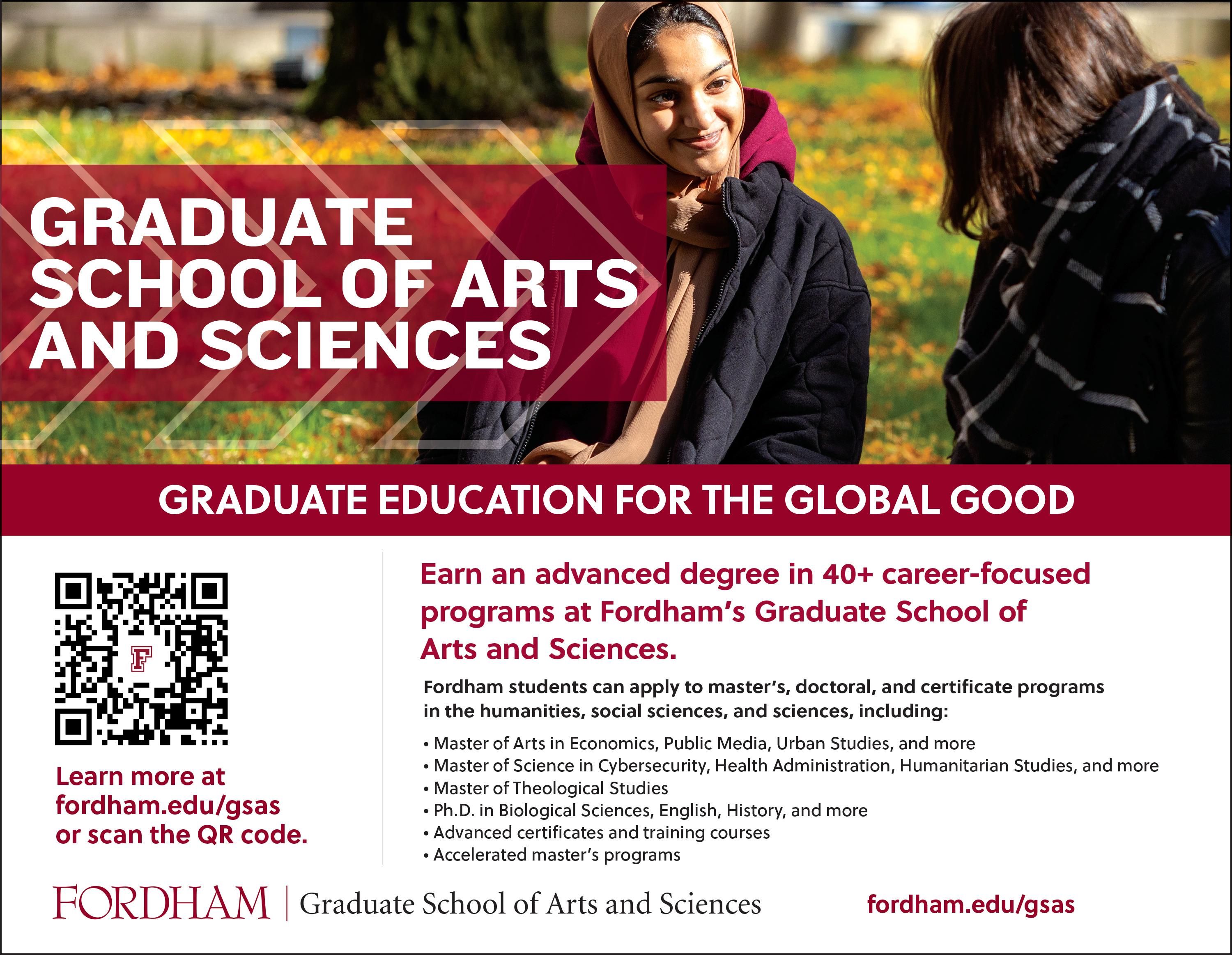
to the
struggles
Sylvia delivers a series of hoops through which the staff must jump, bringing tensions to a mere simmer. The feared manager uses the group’s worries of termination against them, even making newcomer chef Monique (A’ryee Innocent, FCLC ’23) choose between two staff members to be terminated by the end of her first shift. Acuña brings a sickly sweet delivery to the character, leaving no room for personal responsibility, as she pits the staff against each other to watch from her high tower.
“La Cocina” tells a story of class, culture and exploitation all centered around the heart of a community that emerges from a diverse workingclass staff.
Everything about Sylvia, from her sequined clothing to her sharp tone, speaks to a larger movement of figureheads who see value in the commercialization of culture. This was also thematically represented in the production’s program, which features the names of French dishes and kitchen roles, despite the assumption that the kitchen will be producing Latin
of working-class employees and immigrants in its final mainstage production of the semester
food based on the play’s Spanish name. During the show itself, the menu seems to be more of a collection of fancy dinner dishes, further bringing attention to the exoticized marketability of culture and the “authentic” dining experience.
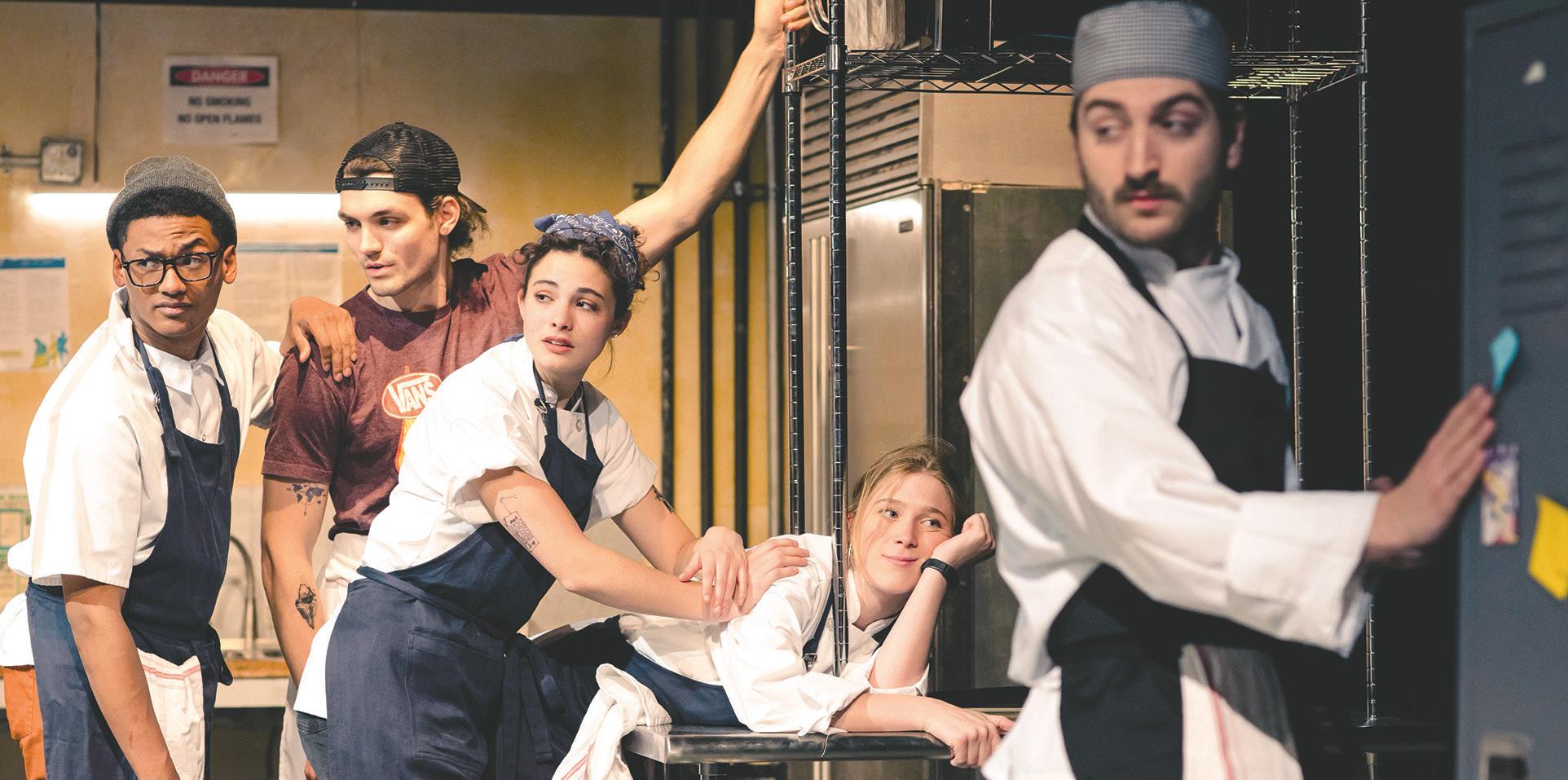
Tensions rise as Pablo becomes increasingly frustrated with his position in life as a kitchen worker and reaches a full boil when he contemplates
whether there can truly be more to life. Pablo craves an escape from the restrictive nature of his job at Sylvia’s restaurant and yearns for mutual trust and respect unattainable for the subordinated working class.
Pablo’s struggles are further accentuated when a homeless man, who was a veteran, enters the kitchen through the back door and asks for food. Though each staff member empathizes,
none jump to help him because doing so would put their own employment at risk. Individually, the staff might have helped this man, but they have no agency in accommodating his request — the food is not theirs to give away, plentiful as it may be. A former veteran on the staff, Paul (Nathan Brenn, FCLC ’23), refuses to let the man go unfed. In offering him a plate, Paul loses his job.
Ultimately, “La Cocina” tells a story of class, culture and exploitation all centered around the heart of a community that emerges from a diverse working-class staff. There is very little that links these characters to one another aside from their absolute reliance on employment: A story known all too well by many working-class people and immigrants across the United States.
LA COCINA from page 1
PHOTO COURTESY OF CASON DOYLE
14 Arts & Culture May 3, 2023 THE OBSERVER www .fordhamobserver.com
‘La Cocina’ detailed the nuances of labor exploitation set in a New York City restaurant kitchen.
From an American and a Native Pinoy: It’s More Fun at Philippines Fest
The street fair brought attention to Filipino-run businesses across New York City at its first Chelsea location
 By JULIA JARAMILLO AND KATRINA MARTINEZ LUNA Asst. Arts & Culture Editor and Contributing Writer
By JULIA JARAMILLO AND KATRINA MARTINEZ LUNA Asst. Arts & Culture Editor and Contributing Writer
With spring fully sprung and summer in view, street fairs are popping up all over New York City. Among the dozens of fairs, Philippines Fest joined the stage on April 15 in downtown Manhattan from 10 a.m. to 6 p.m. The festival featured Filipino-run restaurants, food vendors and artists.

Established in August 2022, Philippines Fest came about through the efforts of three Filipino business owners: Augelyn “Augee” Francisco, chef and owner of Kabisera in the Lower East Side; VJ Navarro, co-founder of pop-up vendor So Sarap NYC currently featured at Smorgasburg food festival in Williamsburg; and Paulo Manaid, owner of contemporary fashion store Hatzumomo. Alongside them are Daniel Corpuz, a chocolatier and owner of Daniel Corpuz Chocolatier, and Craig Nisperos, photographer and historian for the Philippines Fest. The group aims to provide a platform for Filipino-centric and Filipino-run small businesses to be featured on the metro New York street fair scene.
a Philippines Fest shows that Filipino businesses are able to appeal to people of any culture, not just Pinoy (people of Filipino descent).
With the festival having been located in Chelsea, Francisco emphasized how much the traffic in one of New York’s popular neighborhoods could bring exposure to Filipino culture and small businesses. “There is really that part of being overshadowed, or unrecognized, unseen, unheard,” she explained. “However, what is special about Filipino businesses is also that it’s very rare. People go and find us. And the neighborhood where we are at, people are very open.”
Representation and an introduction to Filipino culture was a common theme reiterated by the co-organizers and entrepreneurs of the street fair. Though the Filipino community in New York City is not as large as it is in other U.S. states, it is sizable. According to the Pew Research Center, the population in 2019 was 236,000 Filipinos. Fordham itself has a growing community of Filipinos who are active in student involvement, such as through the club Filipinos of LC Offering Welcome (FLOW) and seeking to have their culture recognized more on campus.
Elizabeth Gorai, owner of Asian fusion pop-up Mama T in Harlem, described how awareness was so important during the COVID-19 pandemic, when there was a serious increase in discrimination and violence against those of Asian descent. Philippines Fest provides a platform for Filipinos to combat ignorance by sharing their talent through food and crafts.
so unique is we have flavors from other places that we make something of our own.”
And it seems that this fusion of cuisines was well-received at Philippines Fest. One of Mama T’s specialties – Ado Bowl –sold out only halfway through the street fair. The rice bowl, a combination of Spanish-derived saffron rice topped with Filipino adobo (a stock made with soy sauce, vinegar and garlic), is one of the best examples of gastronomic intersection between West and Southeast Asia.
and “balut” (fermented duck embryo). Though people new to this kind of fare may be hesitant to try it, the only thing that was daunting was the incredibly long line of customers that sometimes stretched half the block.
his work when he develops new flavors. “It is a true representation of what I grew up with, as well as Filipino desserts transformed into a piece of chocolate.”
The fair took place between 27th and 28th streets on 6th Avenue, and despite the heavy chance of rain that day, people from various cultural backgrounds crowded the streets. Tents housed eager and welcoming business owners with the Filipino flag flowing from the top. One of the tents was a karaoke station, an integral staple during any Filipino celebration. Having previous experience cooking with traditional foods from different cuisines, Francisco explained that marketing Filipino goods is different compared to Japanese or Chinese food because it isn’t as widely loved and known. She added that to be able to have
Questions of representation aside, what can Philippines Fest offer non-Filipinos? It is a worthy introduction to an unfamiliar culture. The Philippines is a former longtime colony of both Spain and the United States, and has historically been influenced by its neighbors and through trade. Although elements of Chinese, Indian and Mexican cultures have been adapted into the country, the Philippines has not lost its native Southeast Asian roots, making it a fascinating site of both diversity and cultural blending.
According to Gorai, this long history has made Filipino food special. “It’s really a fusion of so many different cuisines, East and West combined. So I think what makes Philippine cuisine
Mama T was not the only tent bustling with business. Another stand assisted by Francisco, “Patok by Rach,” had an endless stream of customers. Within 10 minutes, the stand had sold two full baking pans of kutsinta, a steamed rice cake found throughout the Philippines. We ourselves bought five pieces, and they were delicious.
Another stand, Sisig ng Bayan, closed early because they ran out of their main dish, “sisig,” a popular northern Filipino dish made of crispy pork cheeks cooked in soy sauce, onions, citrus and peppers. Several other pop-ups sold out long before the end of the fest as well, not anticipating the overwhelming reception and turnout from New Yorkers.
For those willing to go even more outside their comfort zone, So Sarap NYC offers classic Filipino street food such as barbecue, “isaw” (chicken intestines), “kwek-kwek” (quail eggs)
At Philippines Fest, it was not only the customers who were in an experimental mood. Whitnee Arenas, the owner of juice store Logan & Co, had just started her business that very day and plans to collaborate with other vendors over the summer. Logan & Co sold juice made of calamansi, a native Filipino fruit that is said to taste like a cross between a lime and an orange. The store also presented its own twist on the classic beverage, offering calamansi mixed with hibiscus, ginger-mint and ube (purple yam).
Corpuz also wanted to provide the festival’s visitors with a variety of Daniel Corpuz Chocolatier chocolates to choose from. Corpuz was the youngest and only Asian contestant in the first season of the Netflix show “School of Chocolate,” and as a formally trained chef who worked in Michelin-starred restaurants, he seeks to incorporate the flavors of the Philippines into his own creations, the most popular being bon-bons.

The chef crafts artisanal chocolate using specifically Filipino ingredients such as pandan (described as a sweet lemongrass), ube and calamansi. The chef eagerly stated that authentic innovation is at the heart of
Aside from food, the fair also had different tents where artists sold merchandise to customers. Manaid sold Filipino apparel from his brand Natibo Atmp. His business, Hatzumono, creates contemporary clothes and accessories with traditional Filipino handwoven textiles.
Another tent featured Alice Xie, the artist behind Meloncholy, and sisters Kristin and Ria Salvacion, co-owners of Kriation Studios. Collectively, Xie and the Salvacion sisters sold their original art which included stickers, washi tape, lanyards, art prints and more. In particular, Kriation Studios had custom anime and bubble-tea themed crewnecks. Beside them was Pinoy of America, a shop selling simple yet beautiful Filipino-inspired jewelry and accessories, each of which incorporated the iconic sun from the Filipino flag into its design.
The co-organizers of Philippines Fest hope to have a fair every month. The location and dates of their upcoming fairs include one in Park Slope, Brooklyn, on May 21 and the other in Times Square on July 9. According to Francisco, however, the goal is to not be confined to New York City with plans in place to host festivals in Virginia and Southern California.
KATRINA MARTINEZ LUNA/THE OBSERVER
The Filipino flag waved above every tent. According to Augelyn “Augee” Francisco, many people came up to her and asked where the flag was from.
“ It’s really a fusion of so many different cuisines, East and West combined. ”
Elizabeth Gorai, owner of Asian
fusion pop-up Mama
T
JULIA JARAMILLO/THE OBSERVER
Paulo Manaid’s brand, Natibo Atbp, sold hats, shirts, scarves, buttons, pins and more. Each one has vibrant, textile patterns indigenous to the Philippines.
www .fordhamobserver.com THE OBSERVER May 3, 2023 Arts & Culture 15
JULIA JARAMILLO/THE OBSERVER Francisco (left) and Alice (right) sell “kutsinta,” a soft, steamed rice cake that is believed to have been developed from a mix of native Chinese and Indigenous cooking methods.
un & ames
Crossword: What Time Is It?
21. “America runs on Dunkin’” and “Eat fresh,” for two
23. Celebrated poet and literary critic whose works include “Debths” and “Spontaneous Particulars”
26. *Child-inspired activity that one might encounter on sidewalks during the summer (2 wds)
30. Garment with breast pockets
31. Instruction given to a dart player: “___ __ the bullseye”
32. Corrective issued when the speaker assumes a female gender (2 wds)
34. Return to a former state
36. Prefix for norms or sexual
38. Kelly Clarkson hit “Since U ____ Gone”
39. Cool treats on a hot summer day, commonly found in gas stations
42. Ending for trust or train
43. *Classic New York activity involving snacks and a blanket in warm weather (4 wds)
60. Michelle with the best-selling memoir “Becoming”
61. Numbers experts, for short
62. Auditioned for the glee club, perhaps
63. Often confused with “less”
64. Has, to be old fashioned?
May 3, 2023 THE OBSERVER
27. 2020 Netflix original show “Never ___ _ Ever”
28. Judy of “Arrested Development”
29. Hollywood ogre
30. Promise for a speedy return, over text
33. Lip balm brand with eggshaped containers
35. What happens to proteins to make genes in DNA
36. Essential protective wear when biking in NYC
37. One who observes
1. Sleeveless sweater or puffer
2. “I’m not budging an ___”
3. Niels, the atom modeler
4. Pen name of the Fordham professor authoring spicy stories, ____ James

5. Set of marketing materials

6. The tour guide group at Fordham’s Manhattan campus (Abbr.)
7. “War on Poverty” org.
8. How one may react to a pickup line, perhaps (2 wds)
9. Slumped or slouched (2 wds)
39. Moniker of American rapper and actor O’Shea Jackson Sr.
40. Ring-shaped (Abbr.)
41. Benz or butyl ender
44. Australasian competition fielding teams from New South Wales to New Zealand (Abbr.)
45. “Beware the ___ __ March”
46. What one might find in a doorframe to mark a height? (2 wds)
48. Type of exodus or media
1.
Get along well with
BY ALYSSA MACALUSO AND KREENA VORA
Someone who frequents the internet or drugs?
*What “What Time Is It” from High School Musical is celebrating (2 wds)
Letter opener?
20.
A Goose Story
47. What one might have done for dinner on a stormy night (2 wds)
48. Foundational note on all keyboards (2 wds)
51. Clooney, Orwell or Michael, for three
55. India’s No.1 D3M Marketing Company!
56. *When Lana Del Rey might feel sadness?
59. Like many quilts
10. First two words of Matthew 7
11. On an ocean cruise, say
12. Auricchio or Mast, for two
13. Slips up
18. Another word for “eyepiece,” with “lens”
22. Drunk driving in Iowa, for instance (Abbr.)
24. Top naval brass (Abbr.)
25. Arms-bearing lobby (Abbr.)
26. Radiohead song that got into copyright trouble

49. Where one may purchase a sofa with a side of meatballs
50. Across’s counterpart, in crosswords

52. Former morning TV cohost Ryan Seacrest’s counterpart, Kelly ___
53. Hurdle for an MBA hopeful (Abbr.)
54. Tai Verdes and Surfaces collab, “Sh___!”
57. Monster’s mouth
BY IRENE HAO
Instructions: Each row, column and 3×3 box must contain the numbers 1-9 exactly once.
It was a(n) __________ afternoon in ________ when I decided to _____ on Fordham’s Rose Hill campus. Upon arriving, I ____________ that there were many people around and I wanted to _____ all of them. I _______ approached one of them, ready to ______ but they ran away, screaming “______!”
I then found another person who was more _______. They __________ behind a ______ and we played a lively game of _____________. I began to feel like part of the Ramily. However, I was wrong. A few ____________ later, I woke up to a truck that said “______ Relief” and a _________. The dog followed me around for ___ days, watching me. Fordham was no longer my home and I began to ____ my belongings. I said goodbye to a few of my ________ and _________ away to my new destination.
4 8 6 1 2 2 4 7 8 4 7 3 6 1 9 8 3 4 8 9 6 9 2 1 8 9 7 6 1 adjective month verb past-tense verb verb adverb verb noun adverb past tense verb childhood game noun plural units of time dog breed noun number plural noun verb past tense verb
58. Married Parisienne, for short 5.
Messy people 10. Green stone symbolizing nobility and wealth 14. Double-bonded carbon compound
Amtrak’s version of European ICEs
15.
16.
17.
Three times, condensed Across
19.
Down
Sudoku
BY ALLIE STOFER RAM LIBS GRAPHIC BY CHAISE JONES








 By FNU AKSHILESHA
By FNU AKSHILESHA




 COURTESY OF FORDHAM ATHLETICS
Declan Lavelle, FCRH ’24, excelled in his start in the second game of the series with impressive records.
COURTESY OF FORDHAM ATHLETICS
Fordham baseball huddles before their first of three games in Philadelphia against St. Joseph’s University.
COURTESY OF FORDHAM ATHLETICS
Ryan Thiesse, GSBRH ’24, has had 177 at-bats this year, driving in 22 runs off of 50 hits.
COURTESY OF FORDHAM ATHLETICS
Declan Lavelle, FCRH ’24, excelled in his start in the second game of the series with impressive records.
COURTESY OF FORDHAM ATHLETICS
Fordham baseball huddles before their first of three games in Philadelphia against St. Joseph’s University.
COURTESY OF FORDHAM ATHLETICS
Ryan Thiesse, GSBRH ’24, has had 177 at-bats this year, driving in 22 runs off of 50 hits.











 GRAPHIC BY AURELIEN CLAVAUD/THE OBSERVER
GRAPHIC BY AURELIEN CLAVAUD/THE OBSERVER






 By JULIA JARAMILLO AND KATRINA MARTINEZ LUNA Asst. Arts & Culture Editor and Contributing Writer
By JULIA JARAMILLO AND KATRINA MARTINEZ LUNA Asst. Arts & Culture Editor and Contributing Writer





